
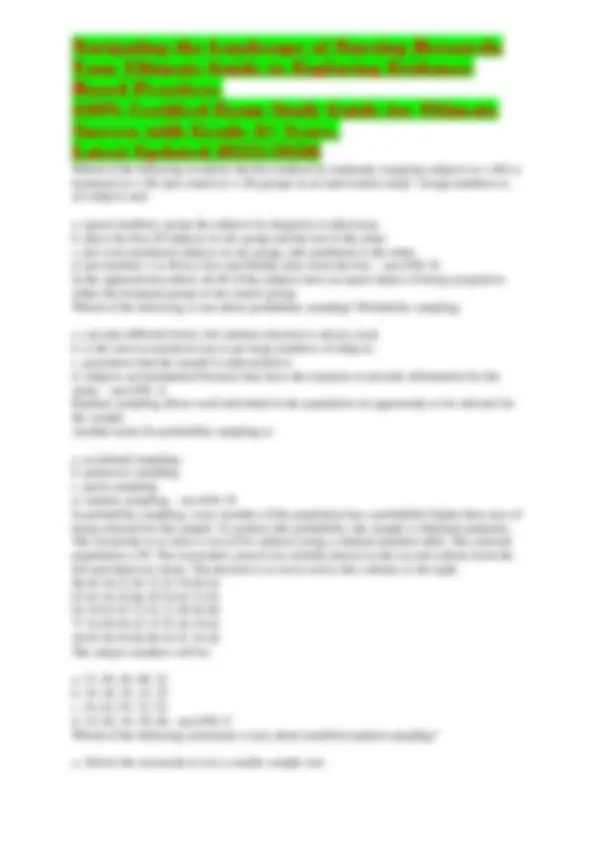
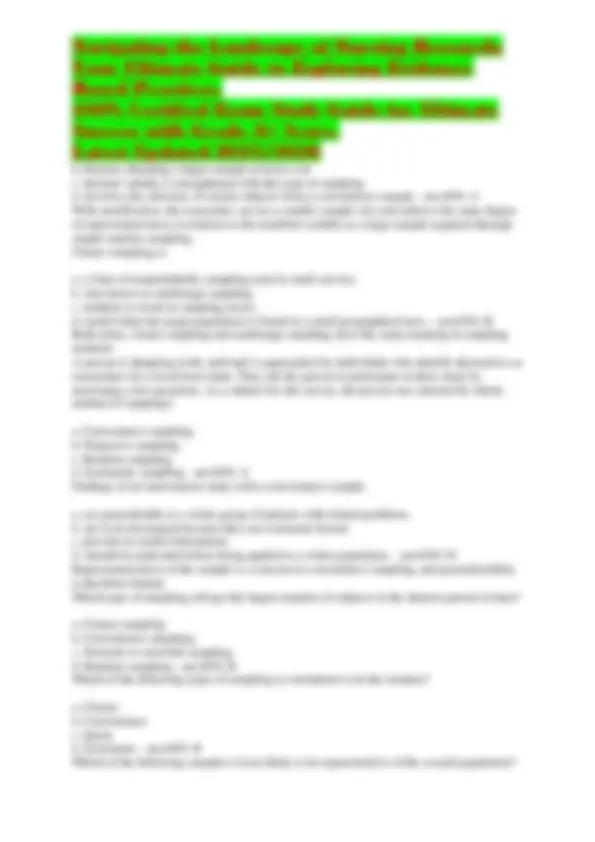
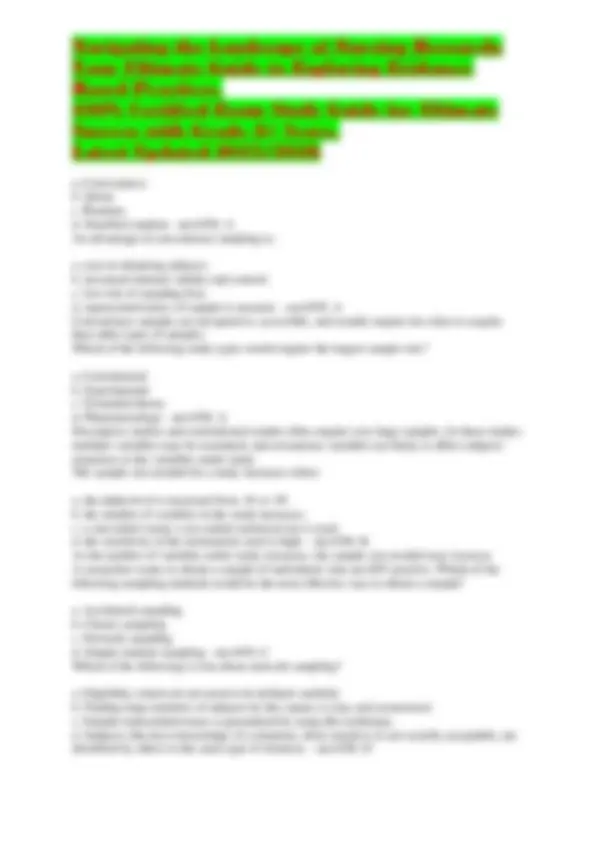
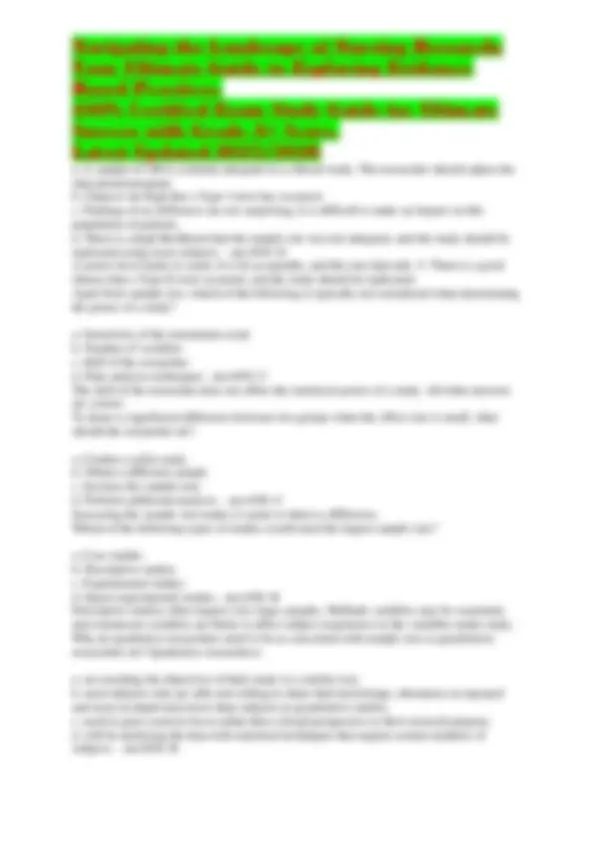
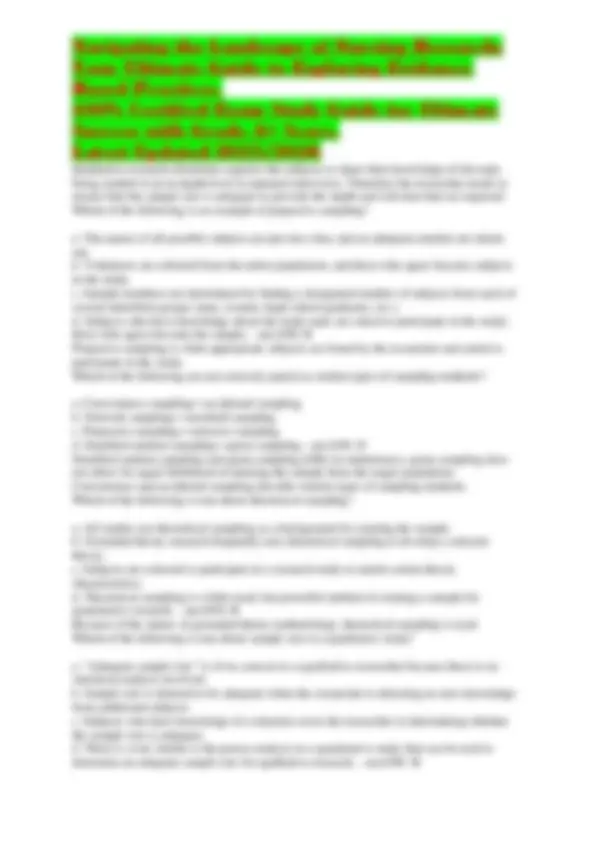
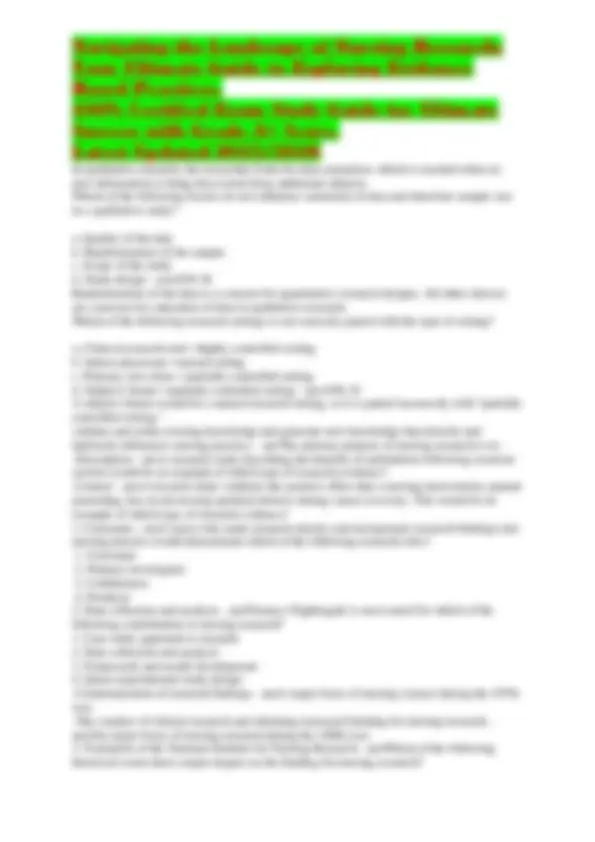
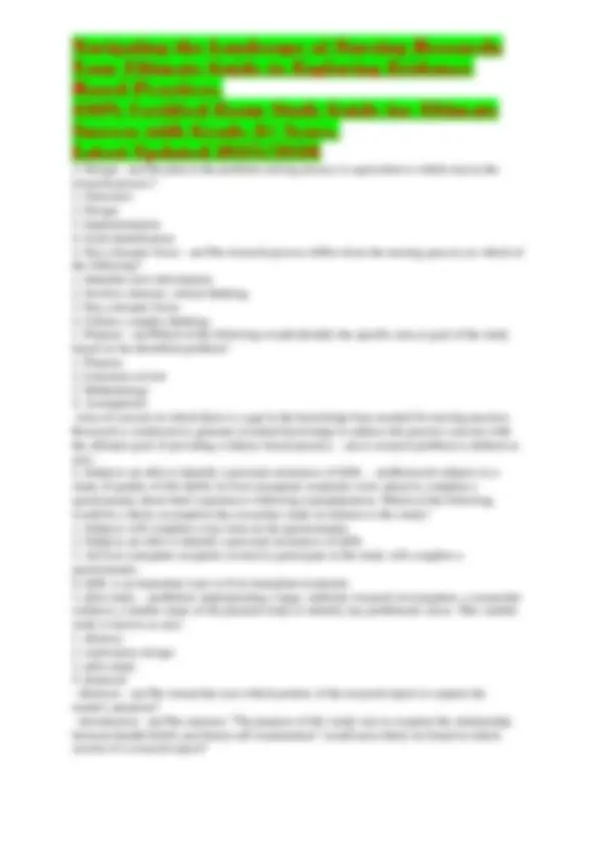
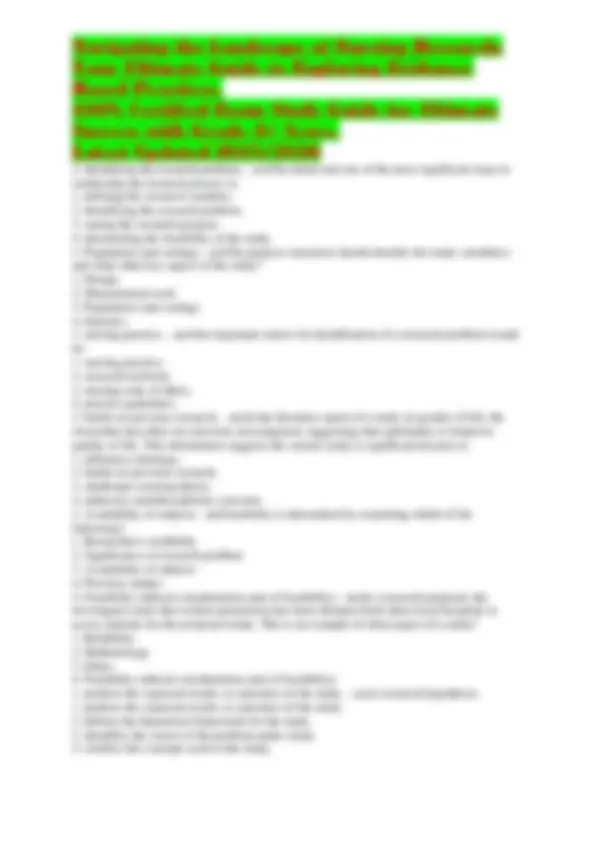
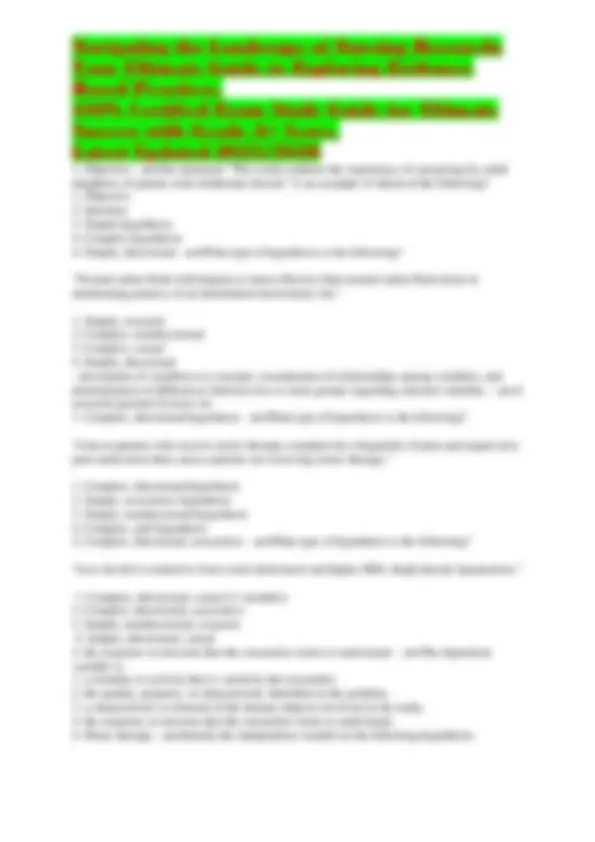
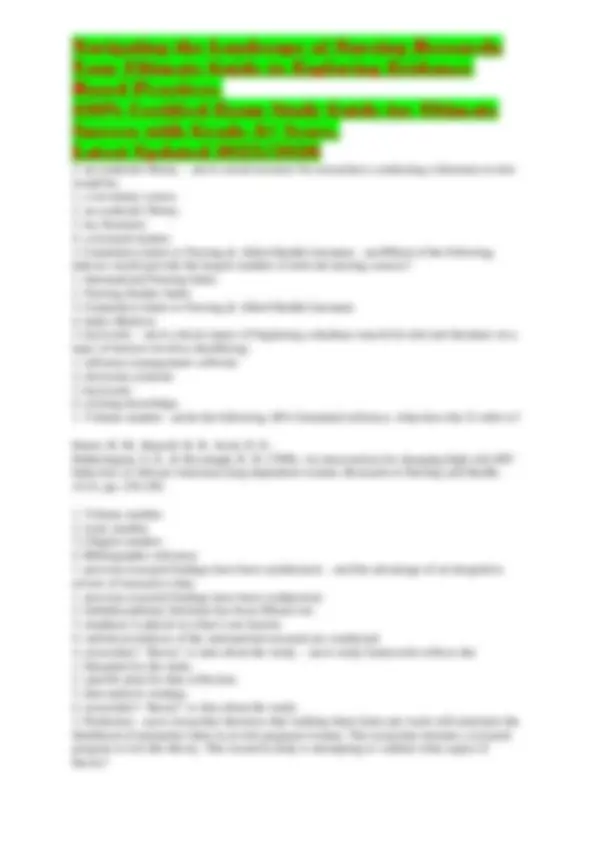
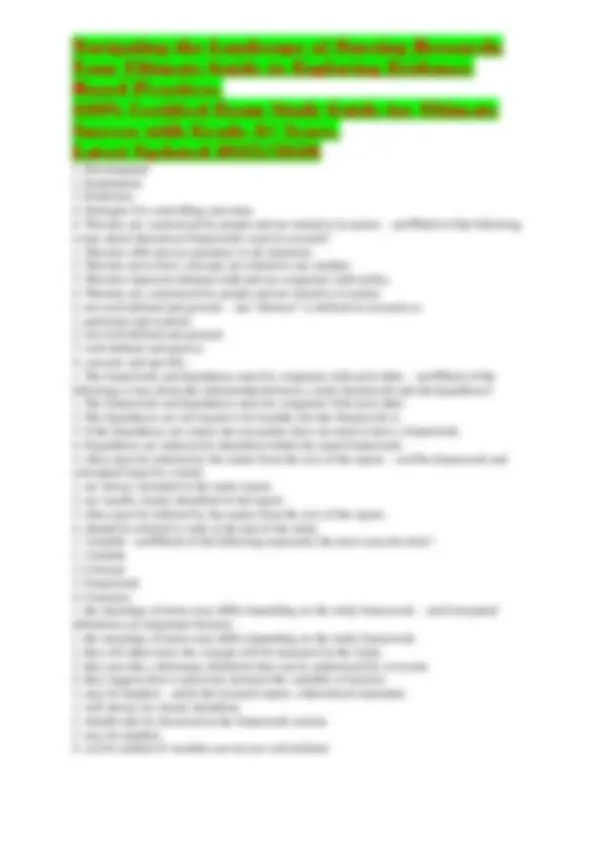
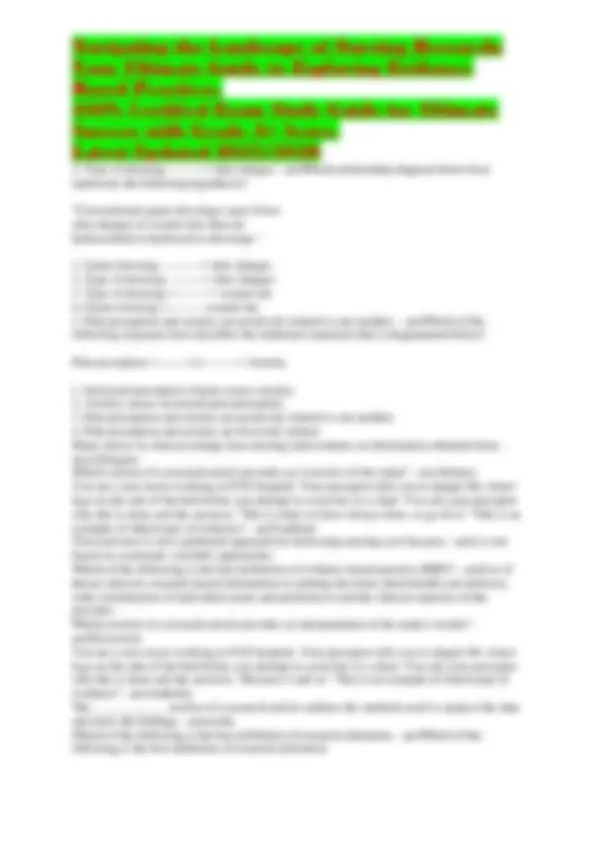
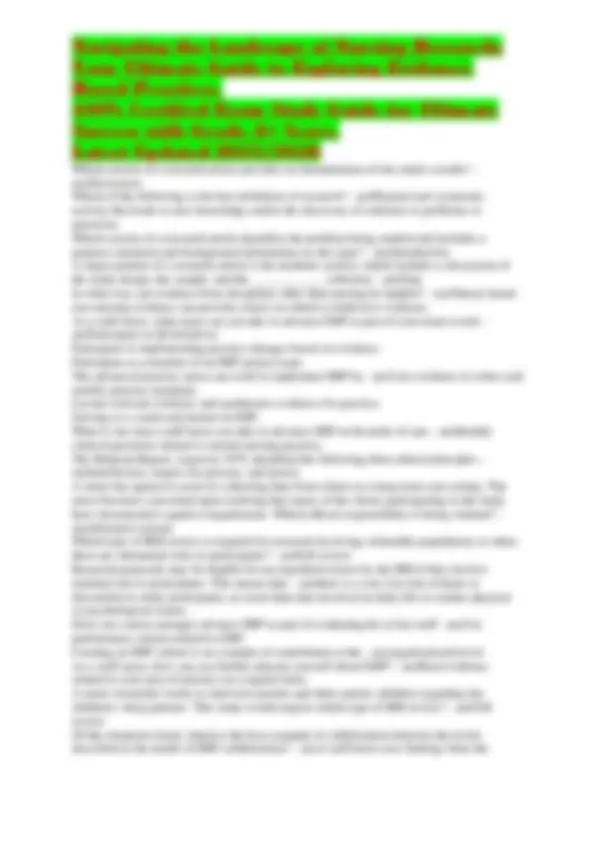
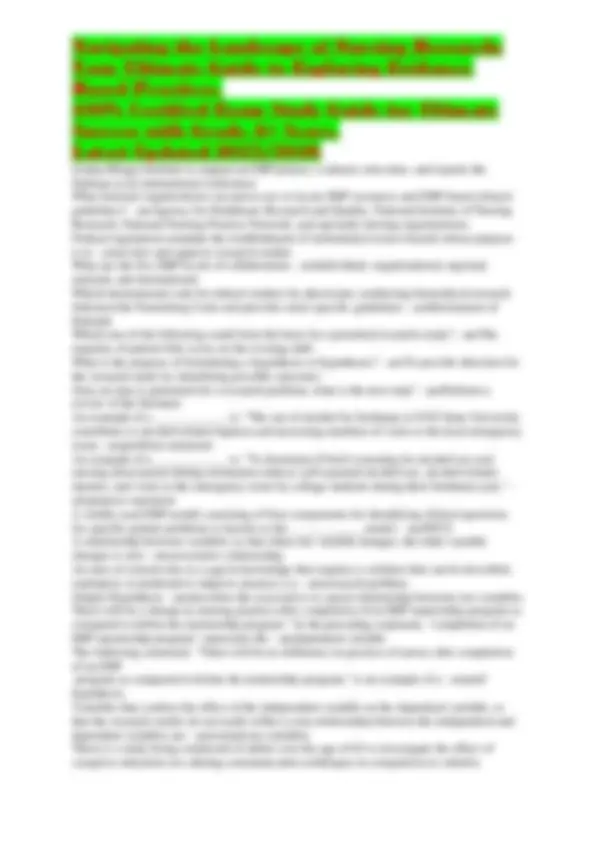
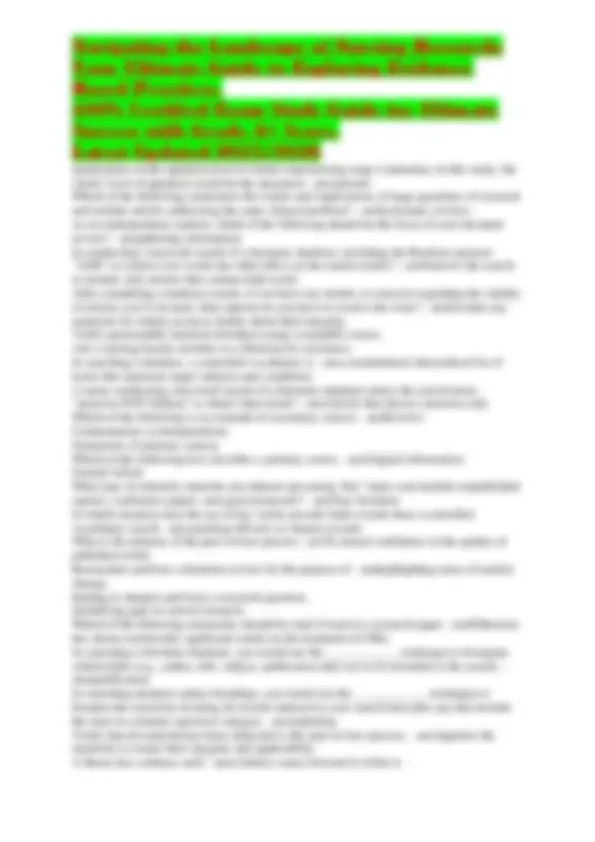
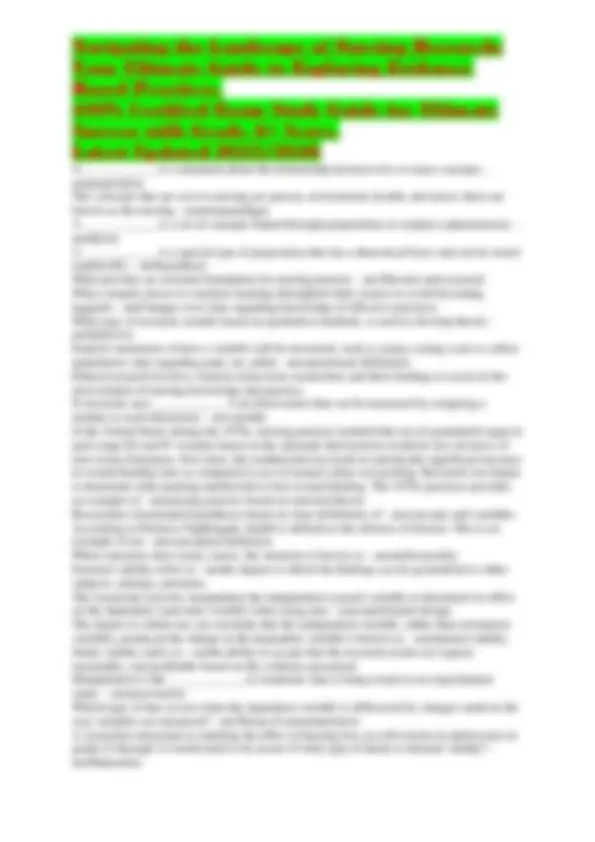
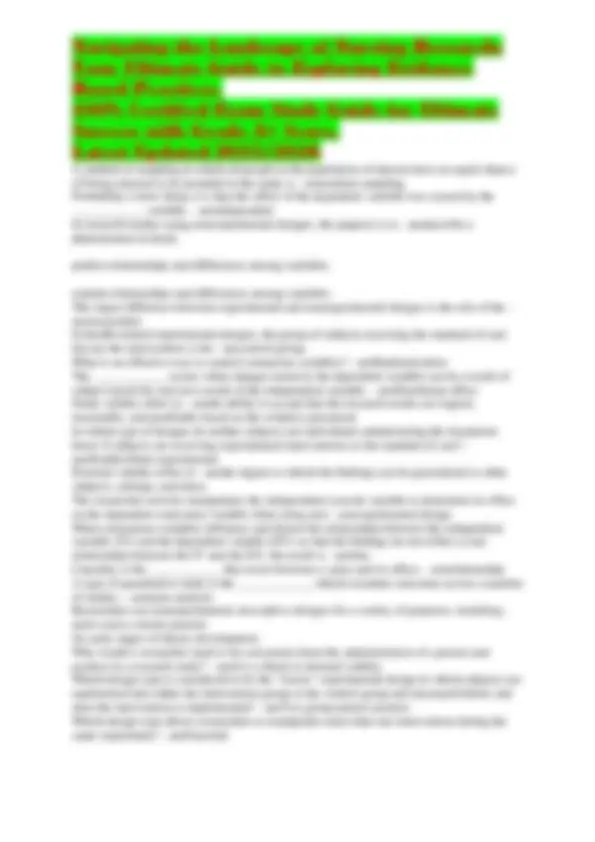
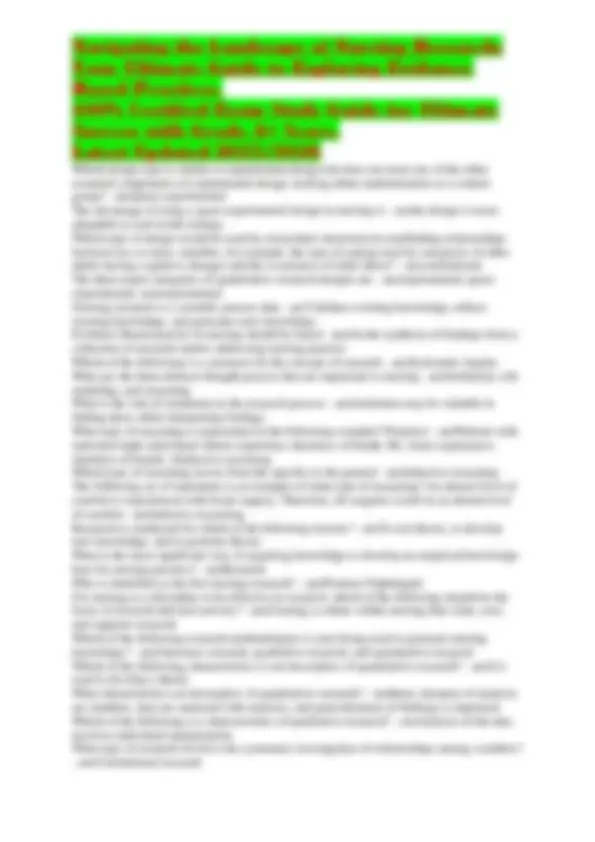

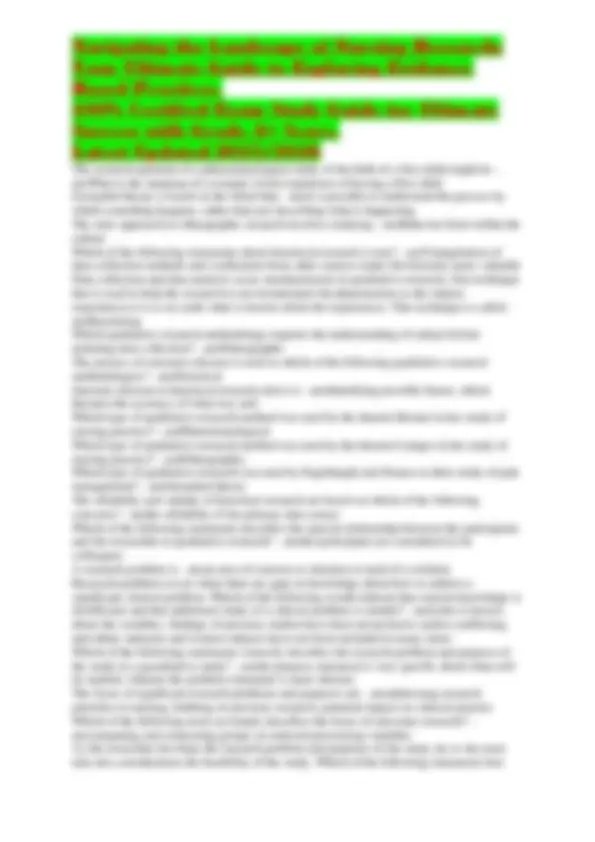
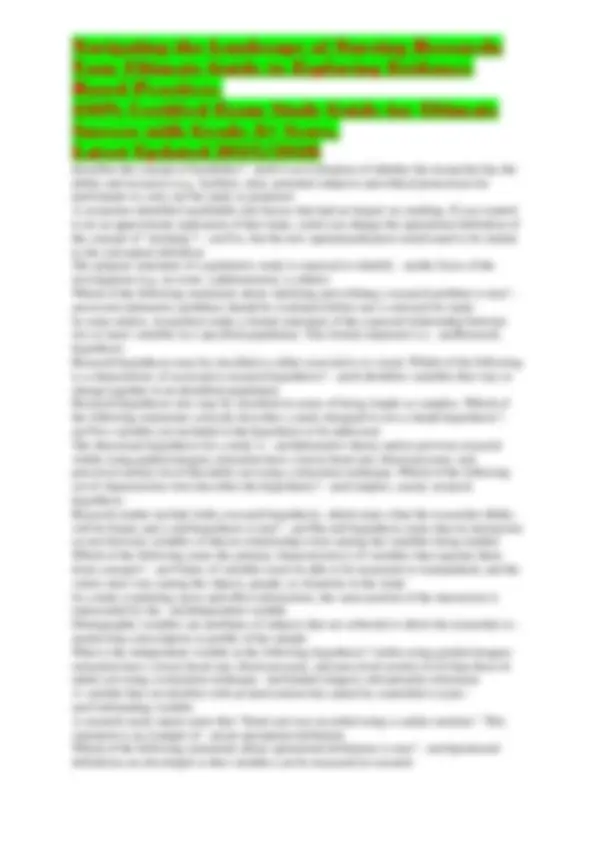
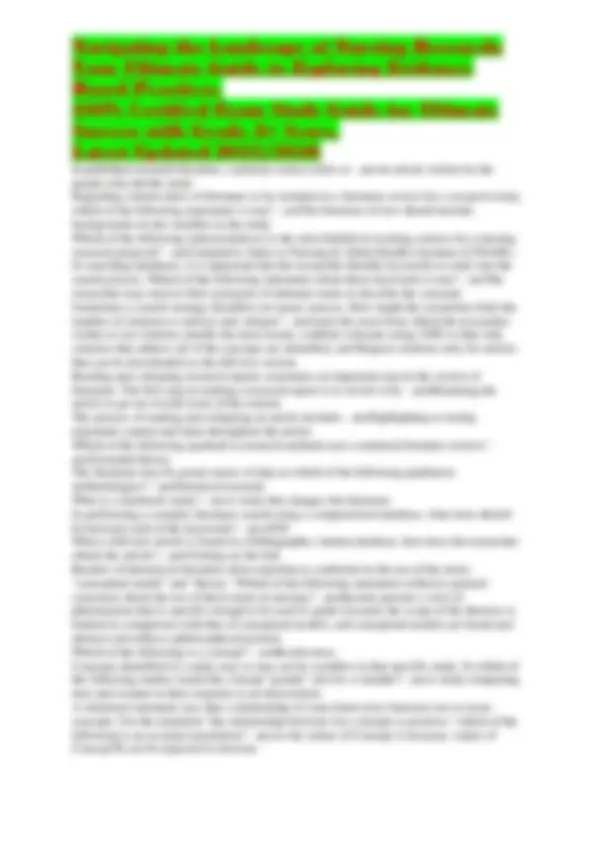
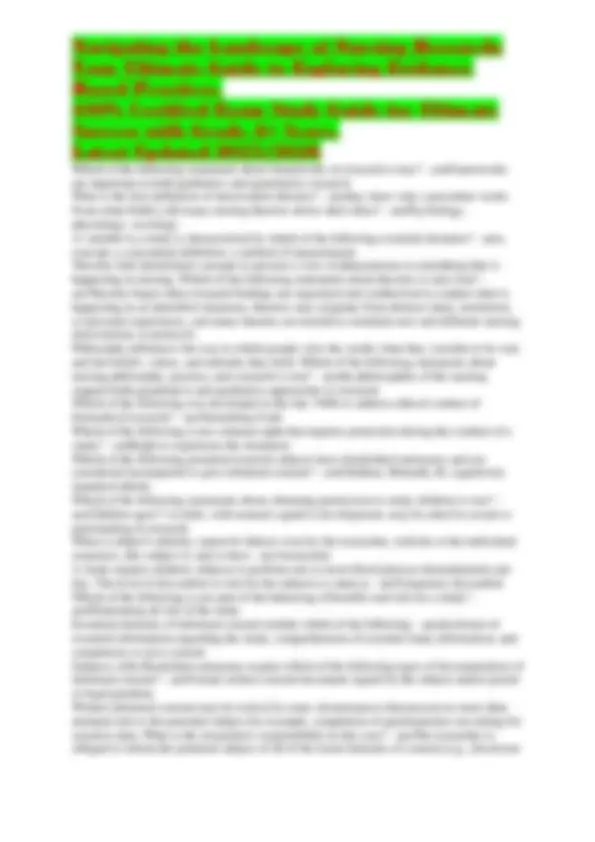
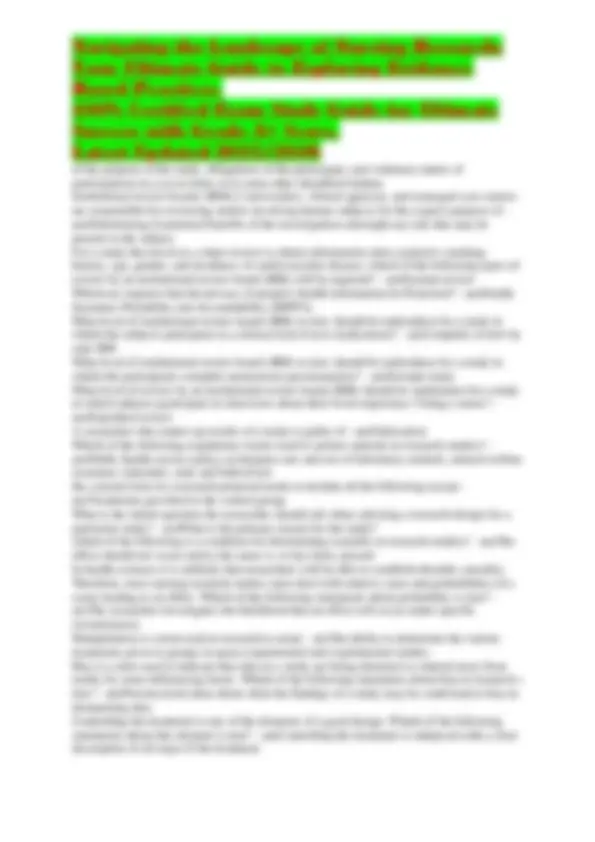
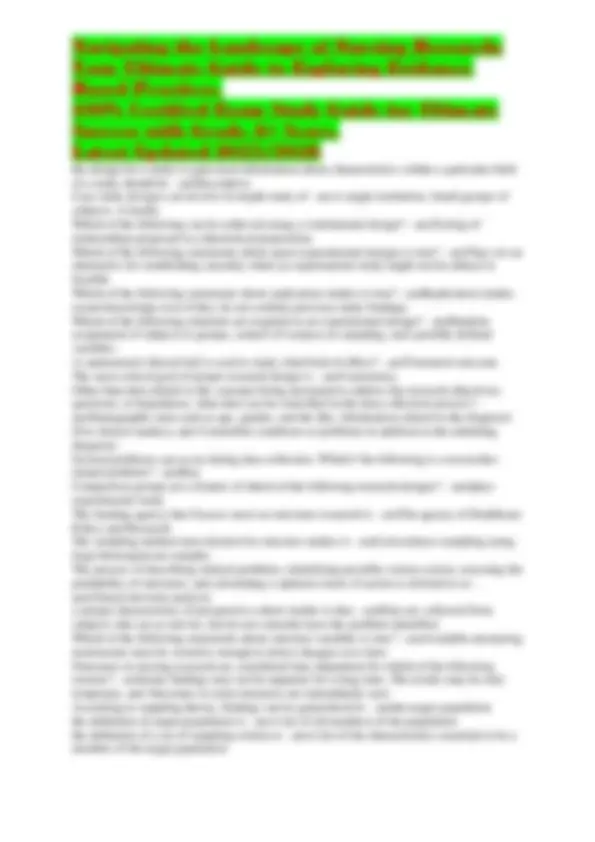
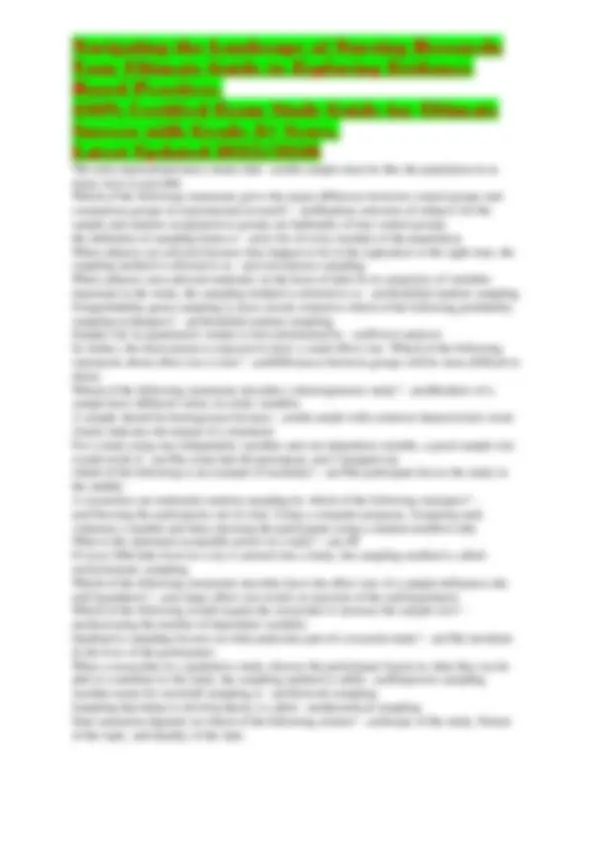
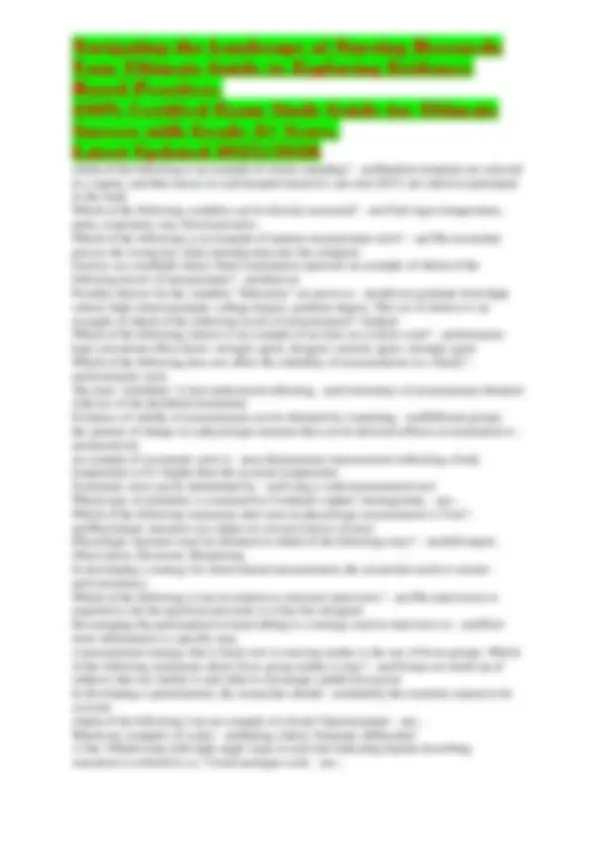
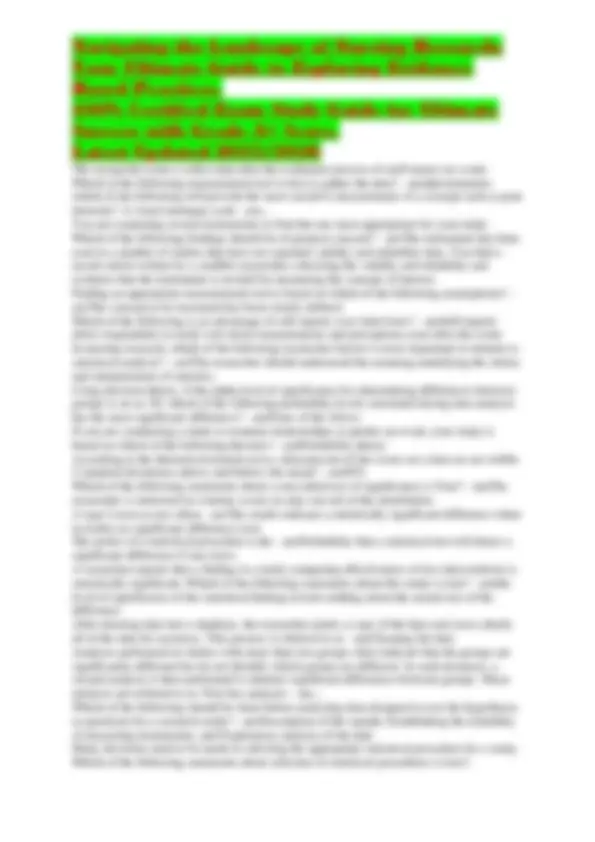
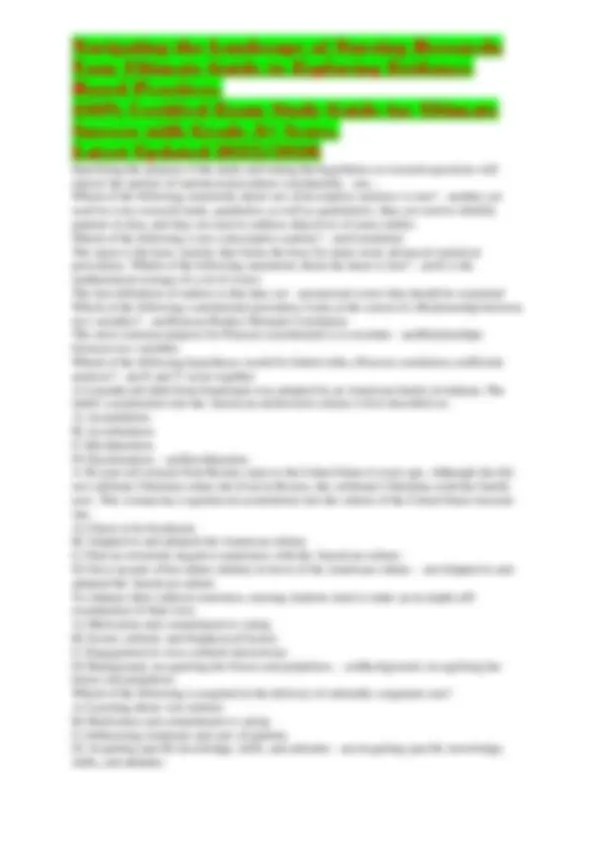
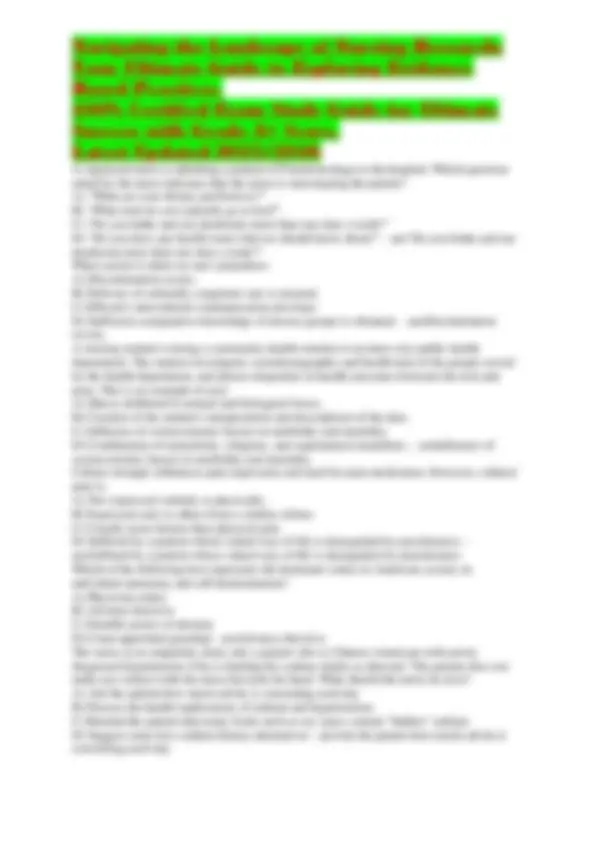
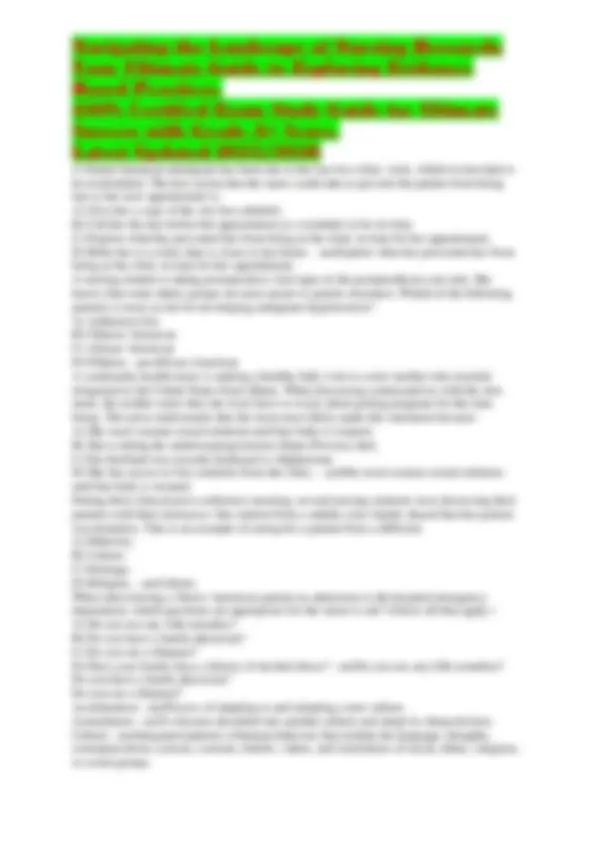
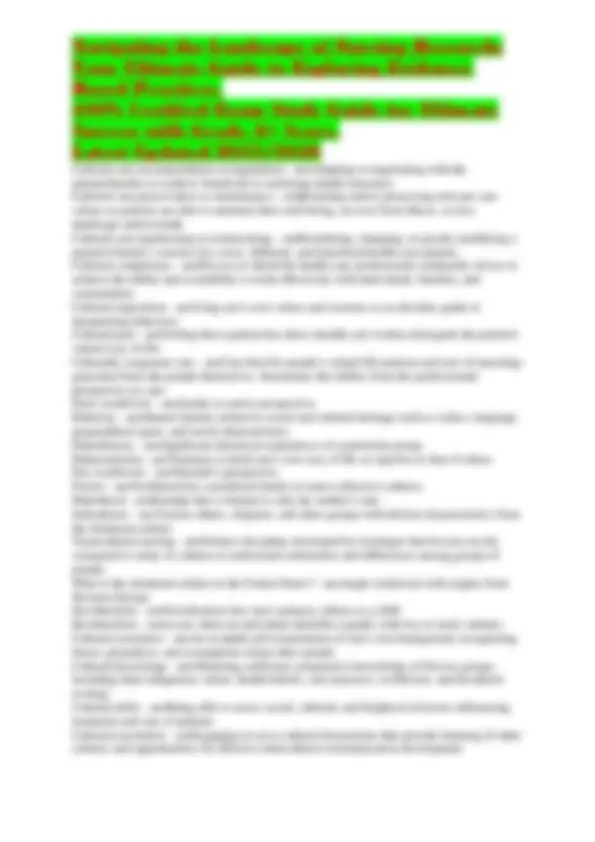
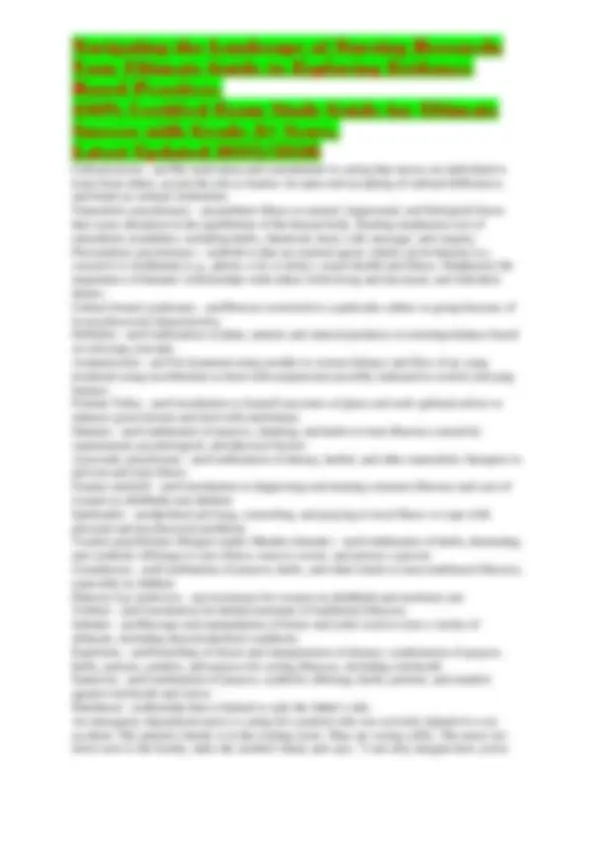
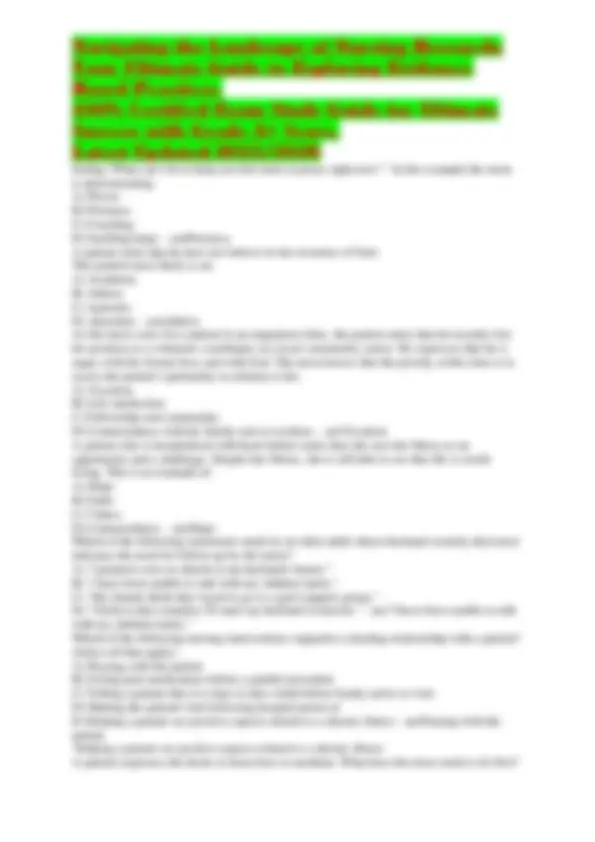
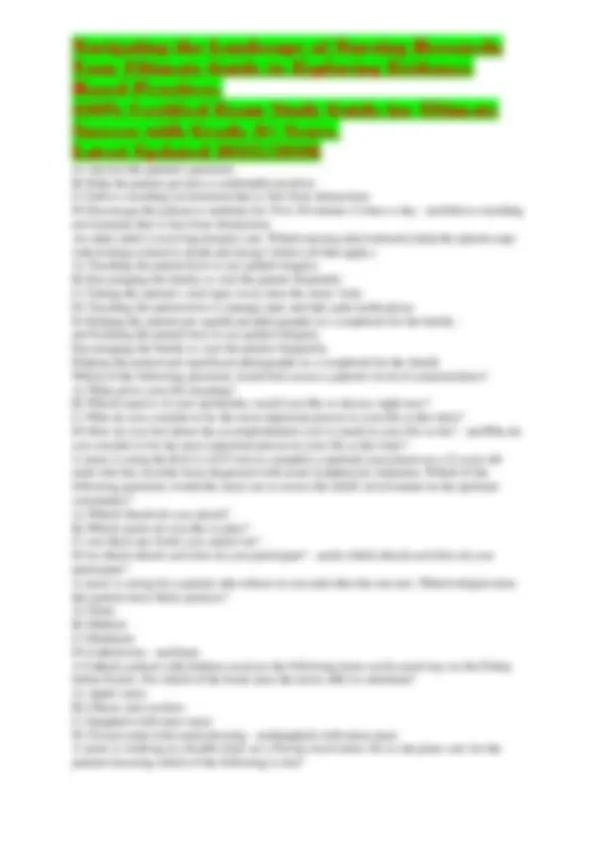
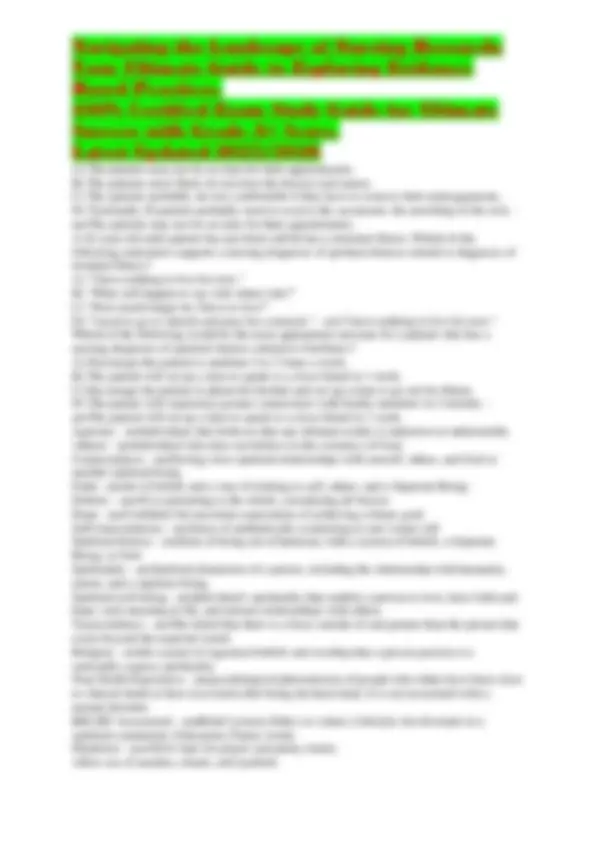
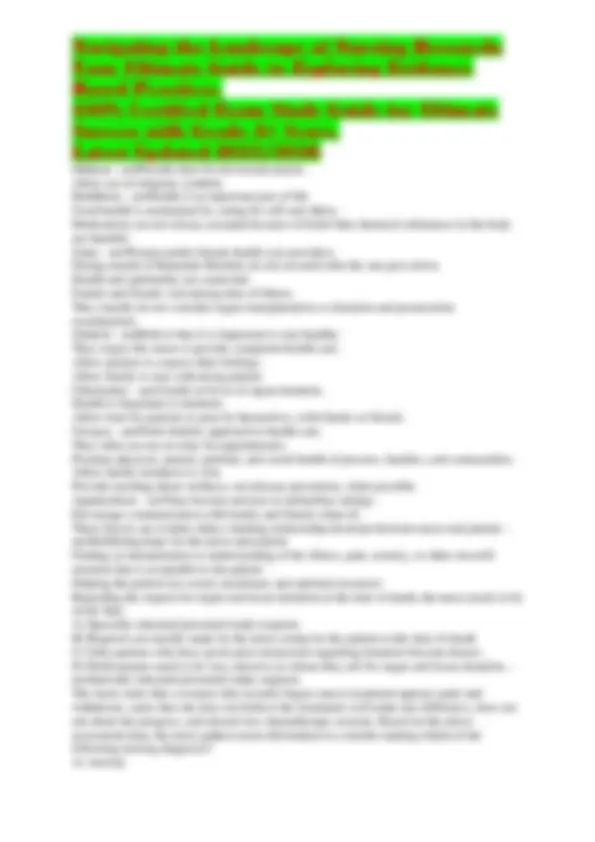
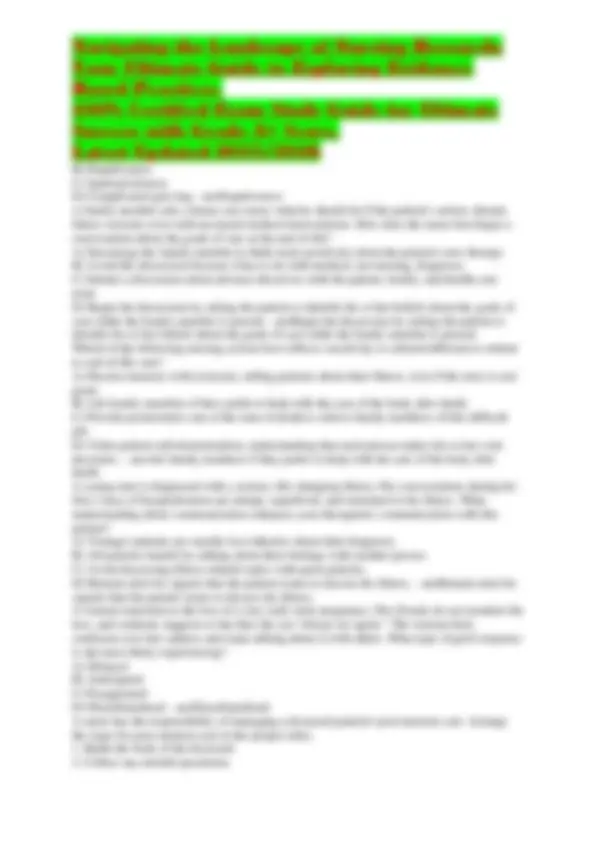

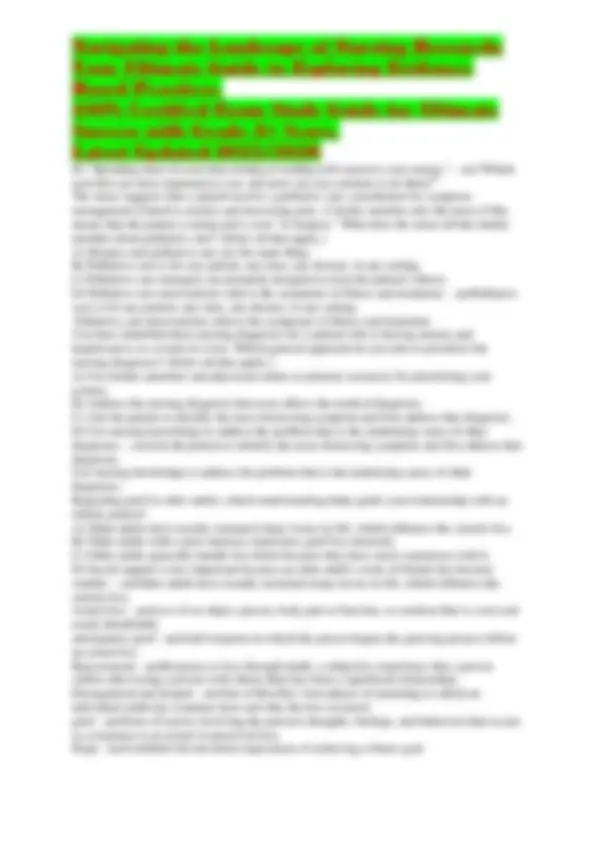
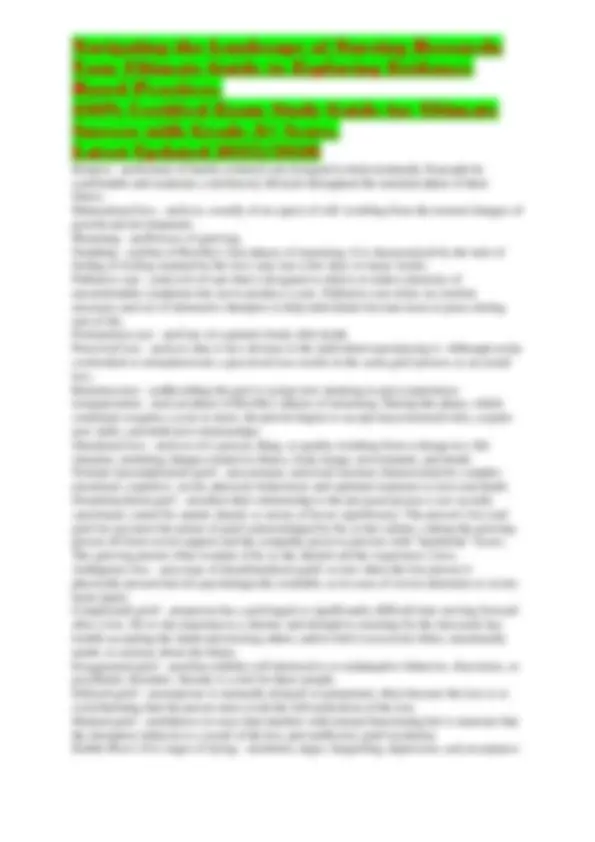
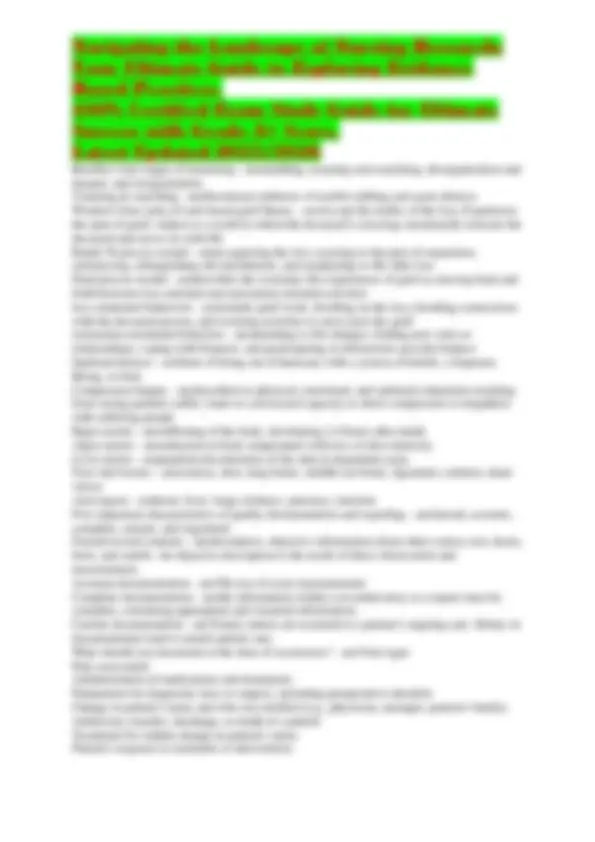
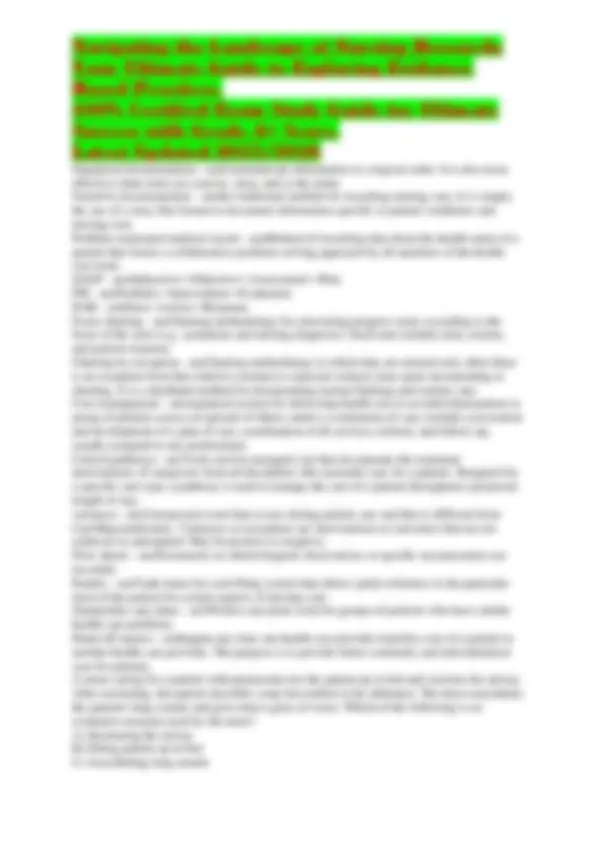
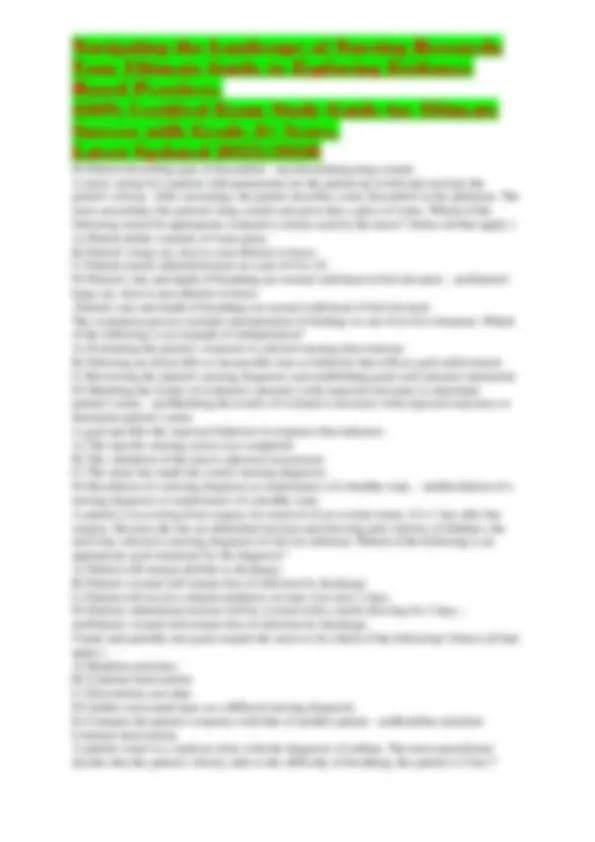
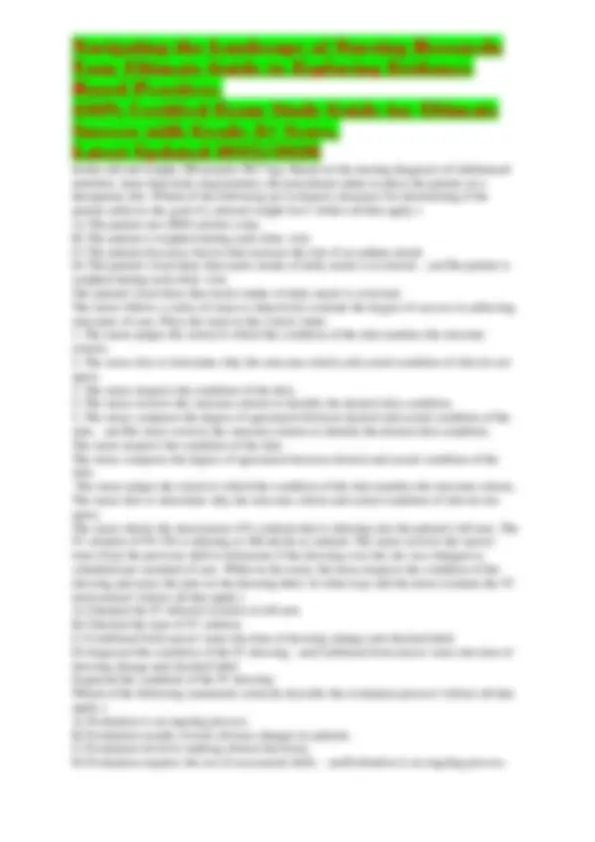
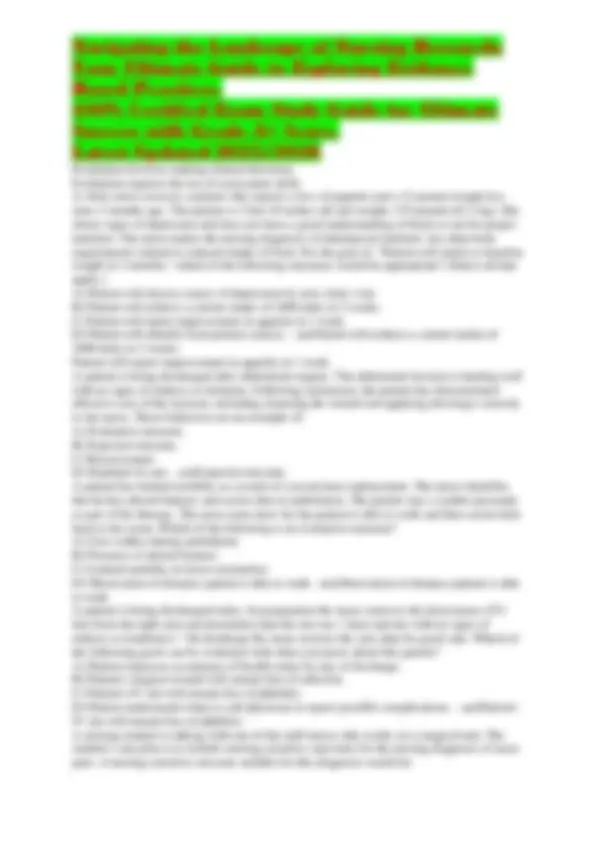
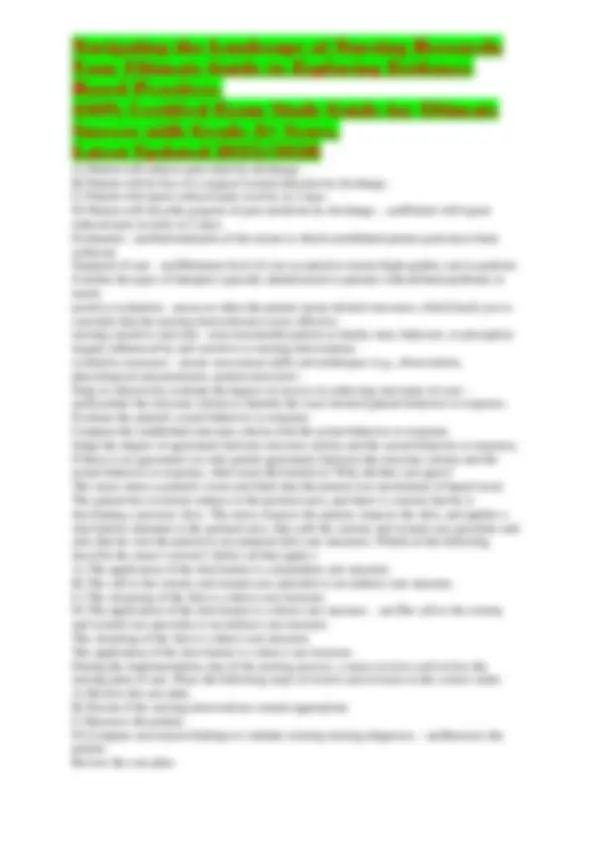

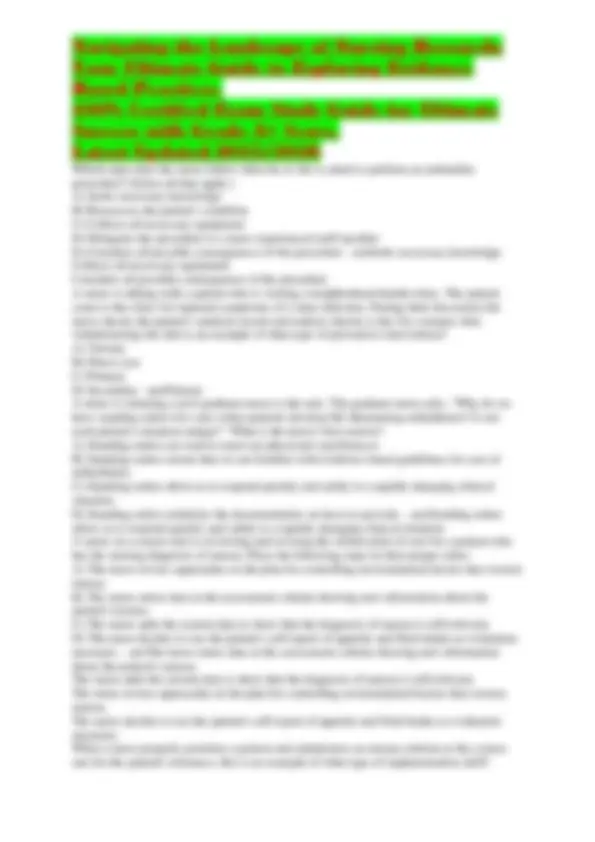
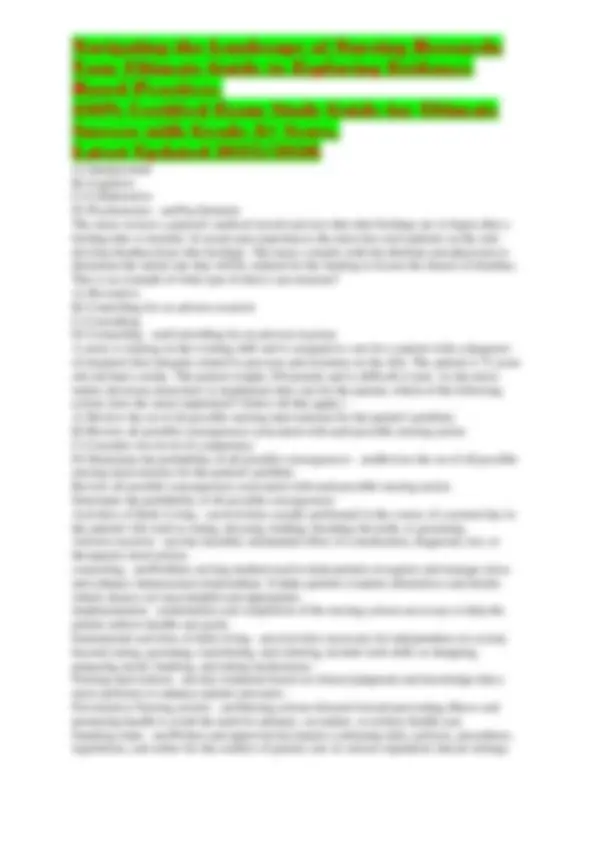
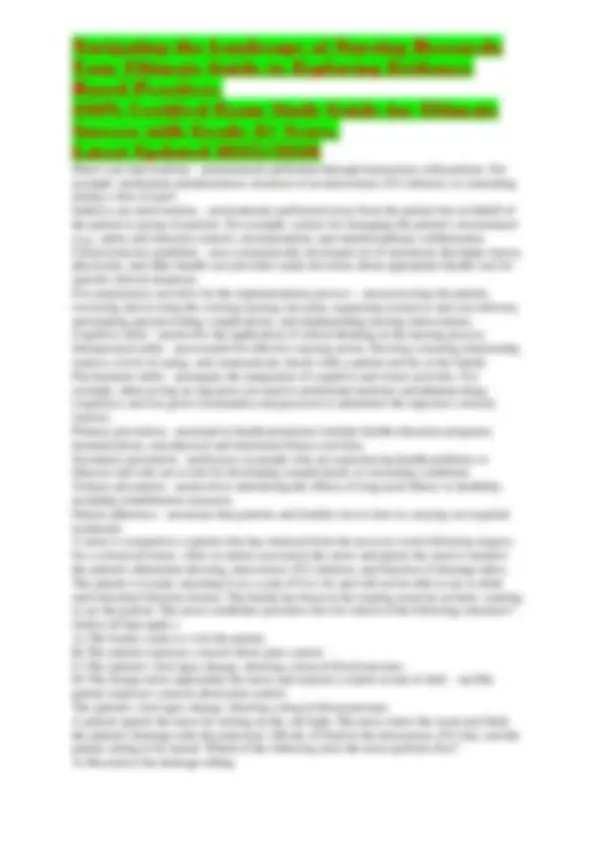
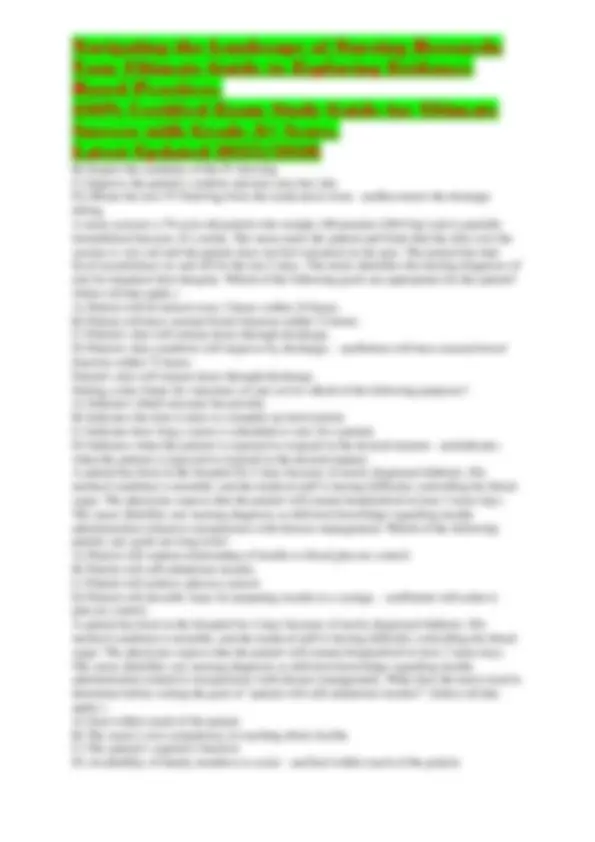
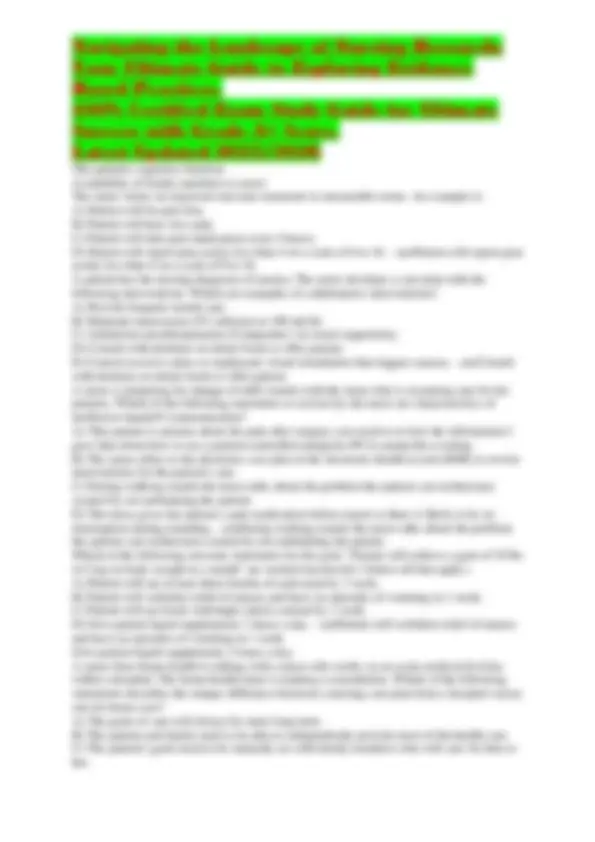
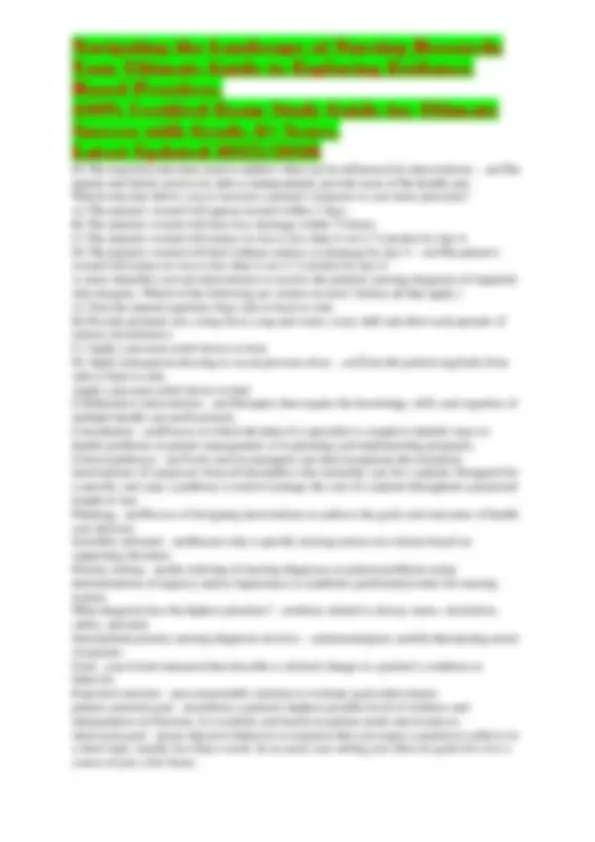
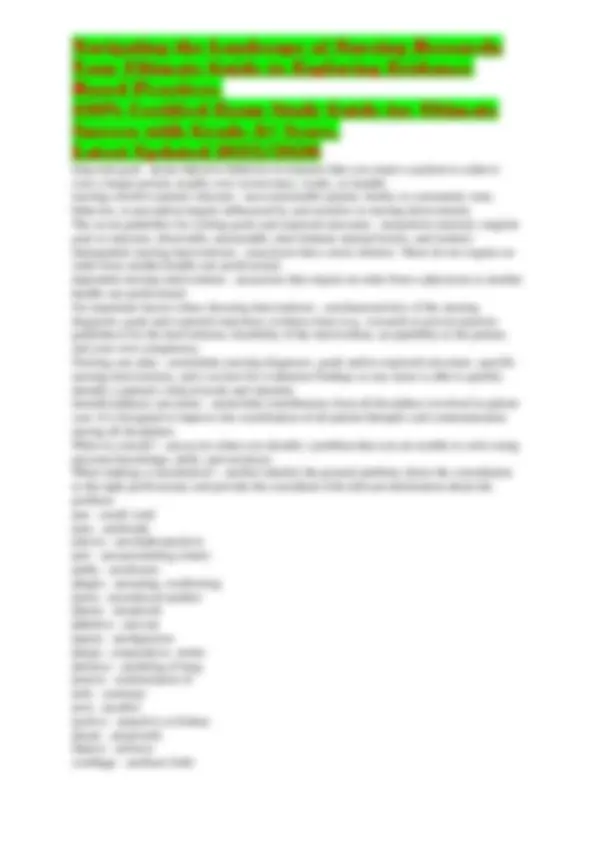
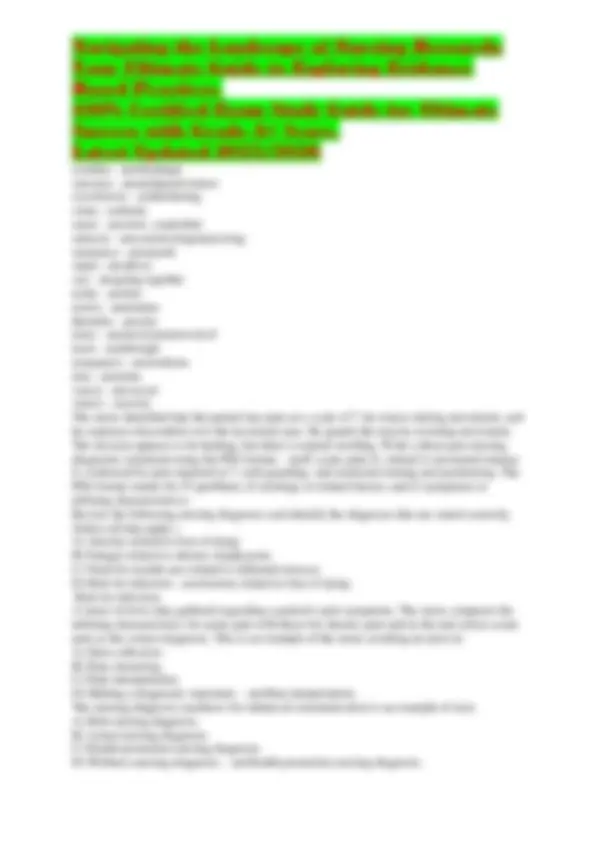
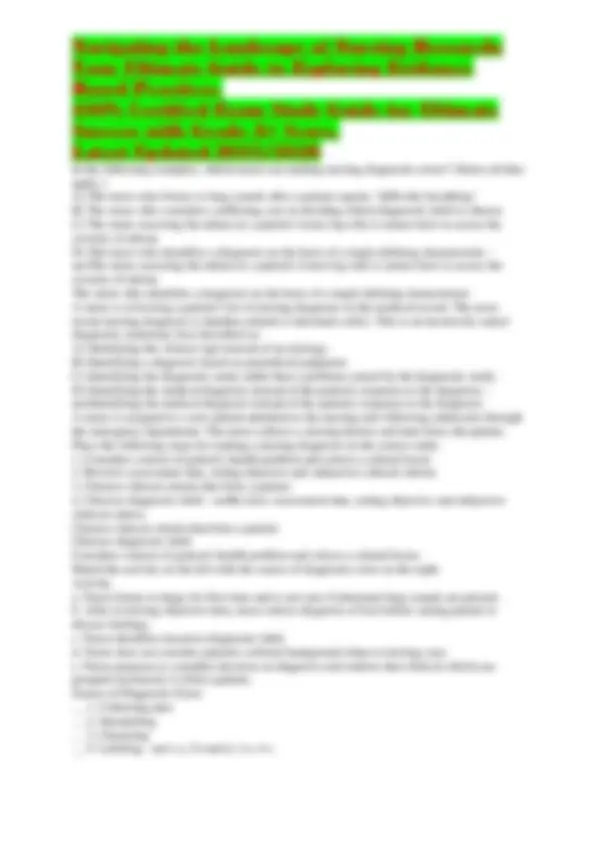
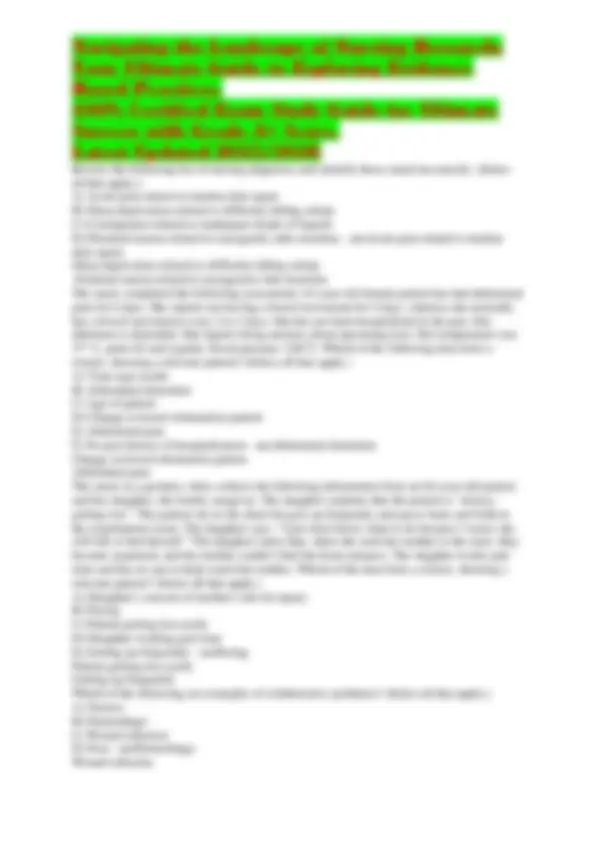
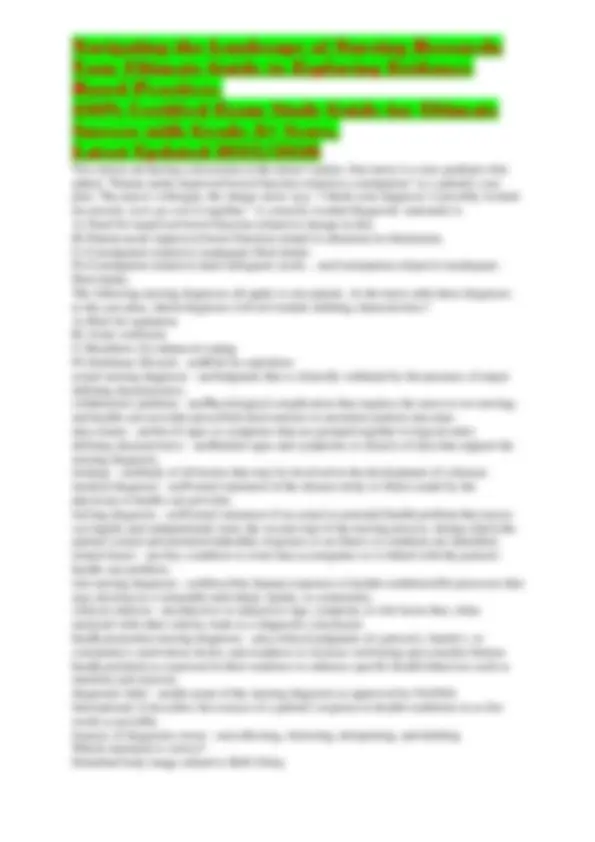
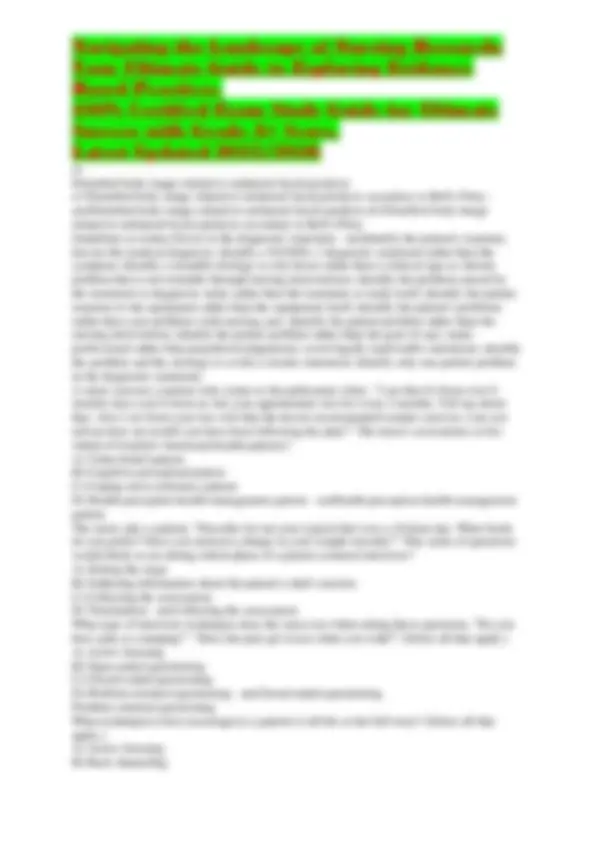
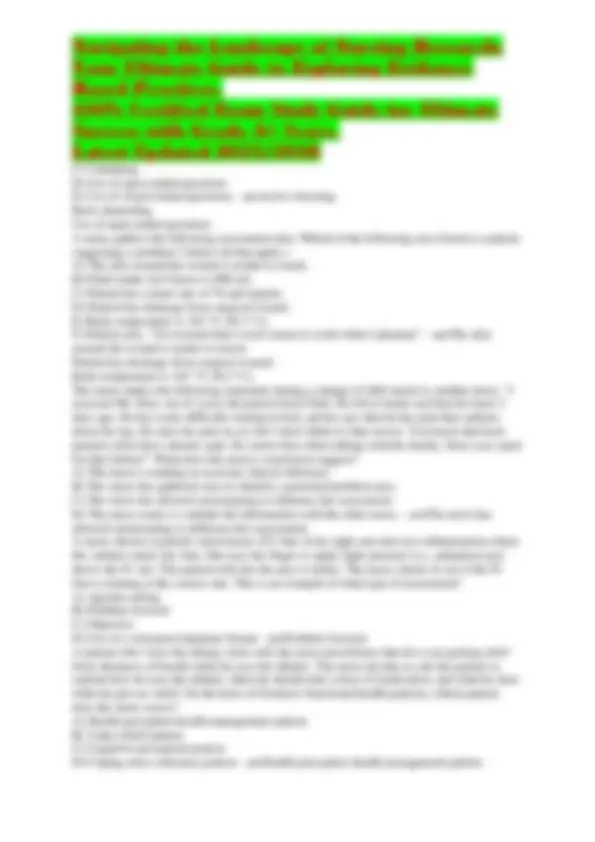
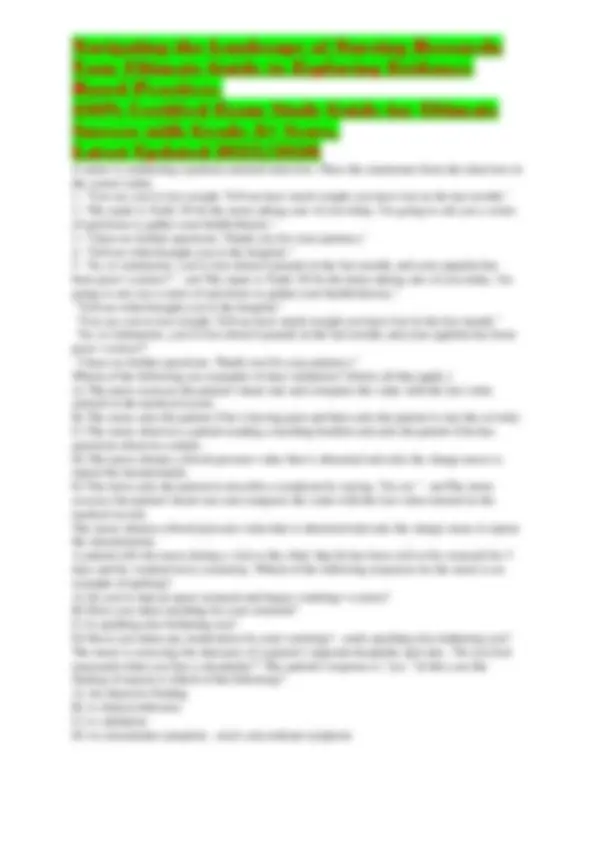
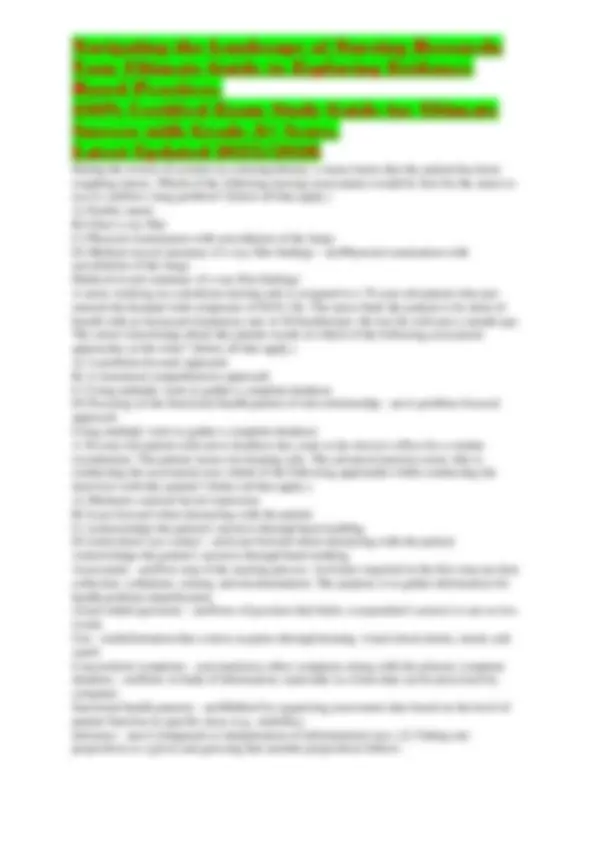
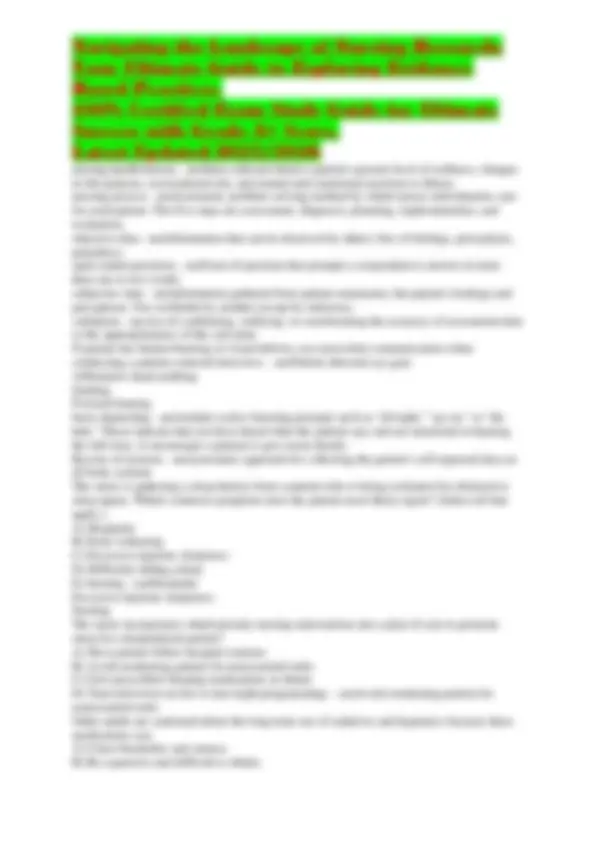
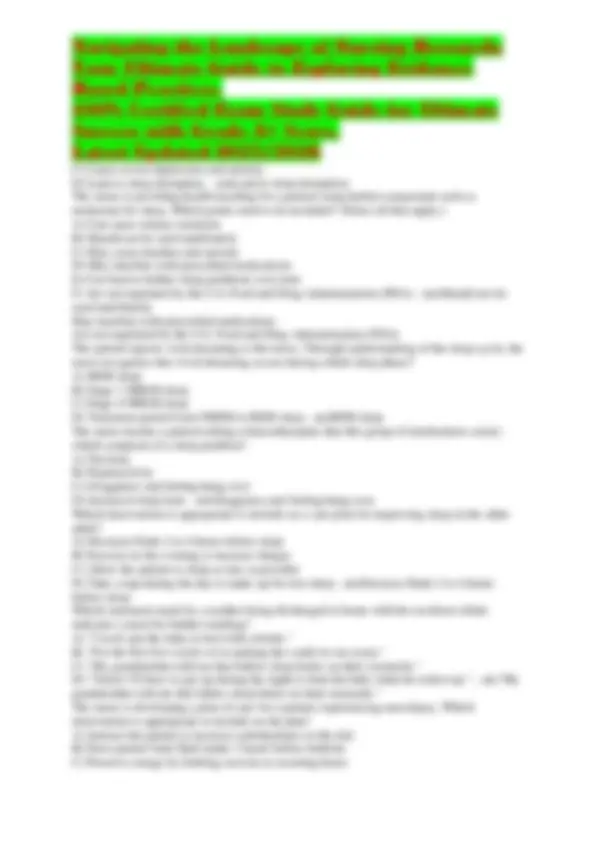
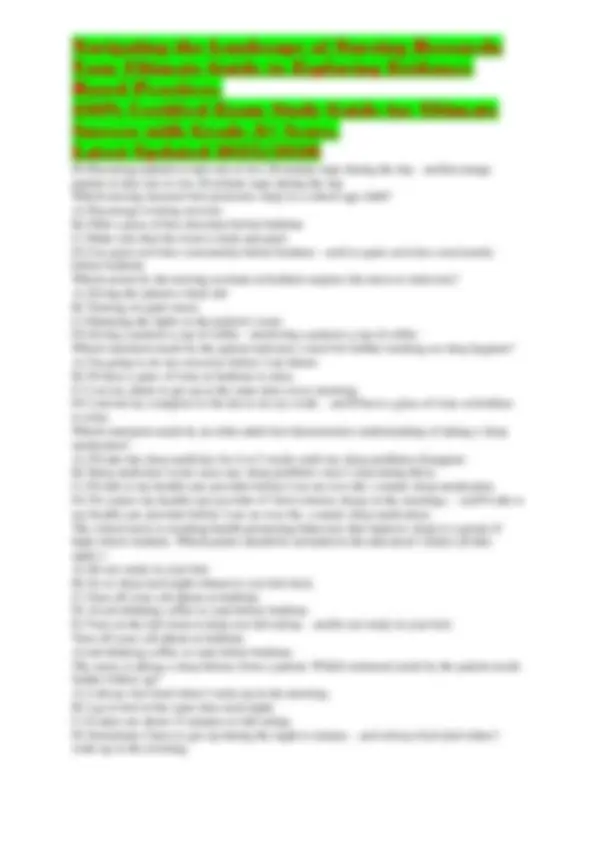
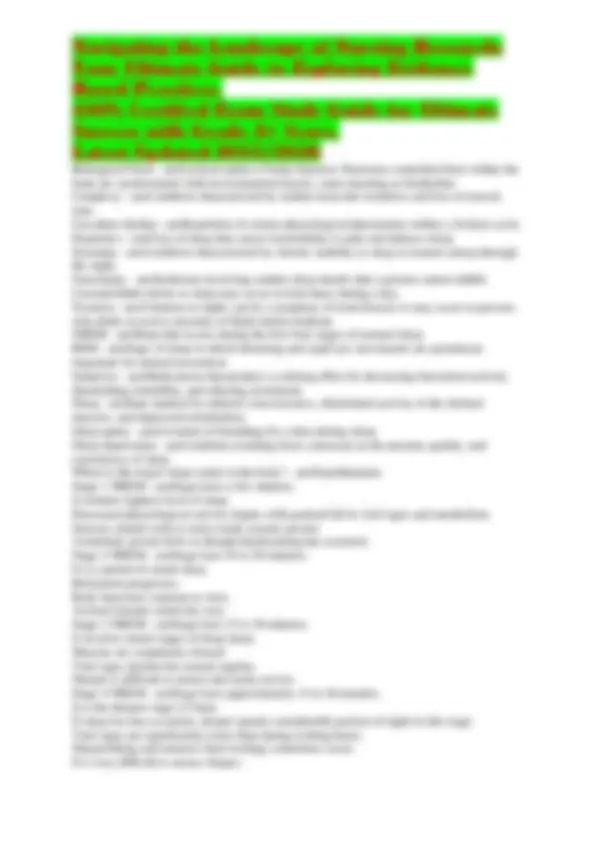
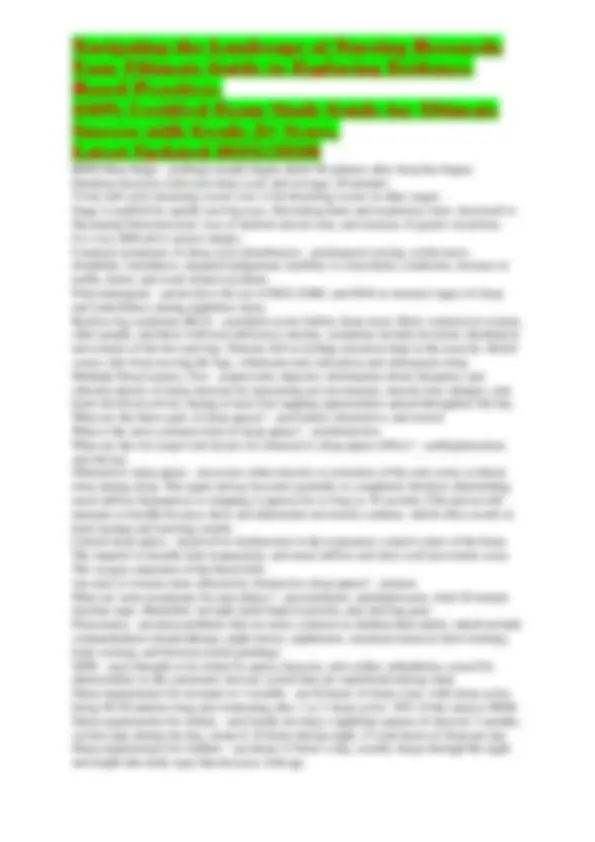
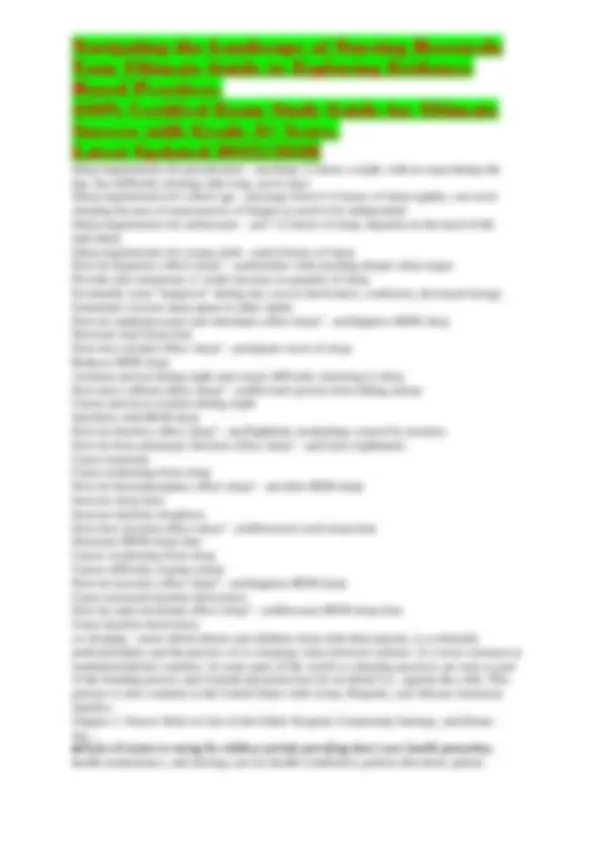
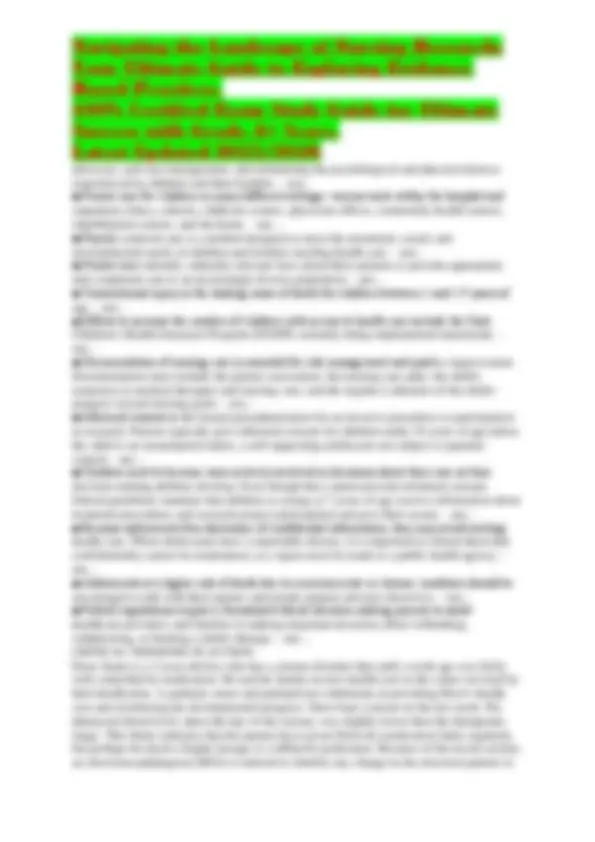
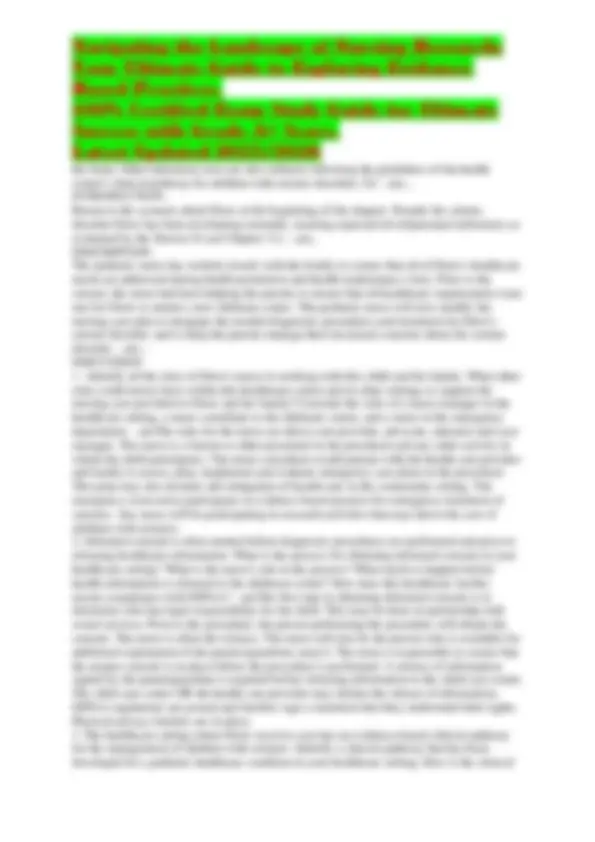
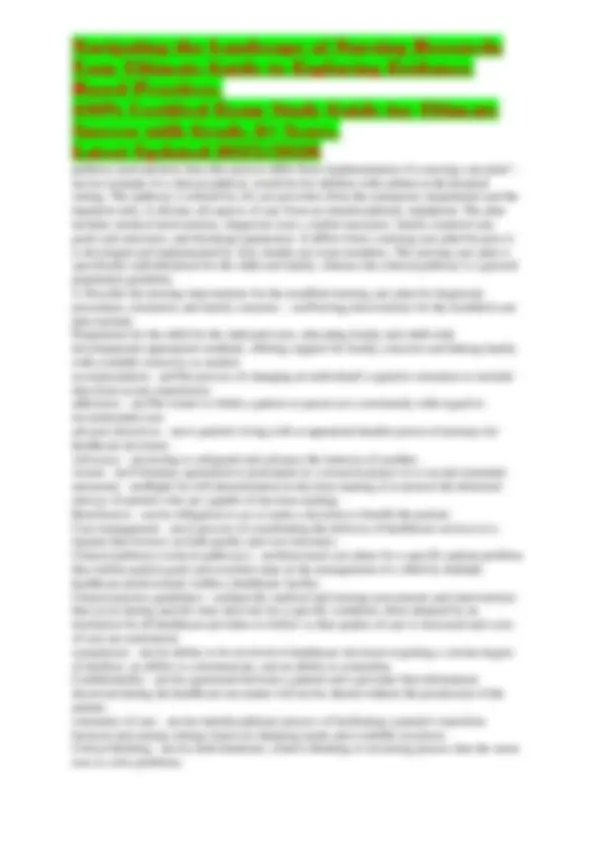
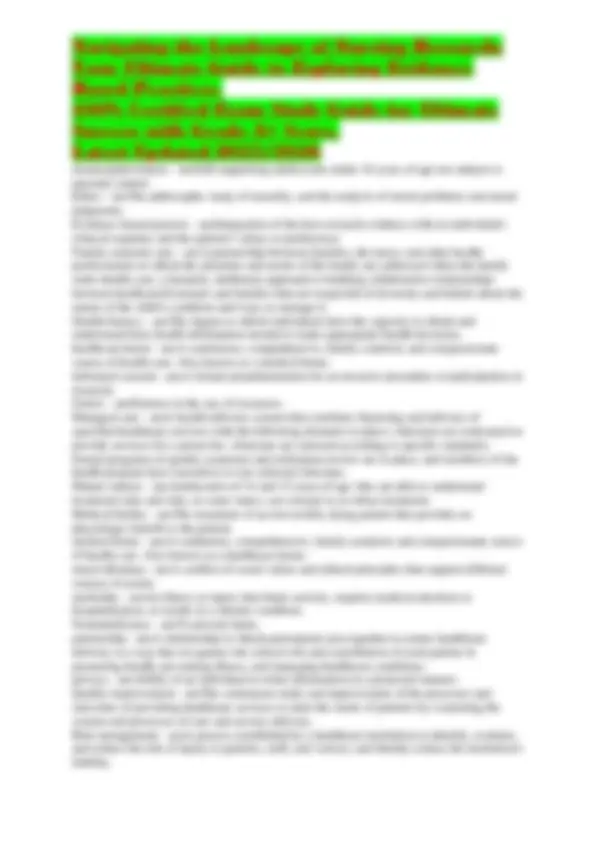
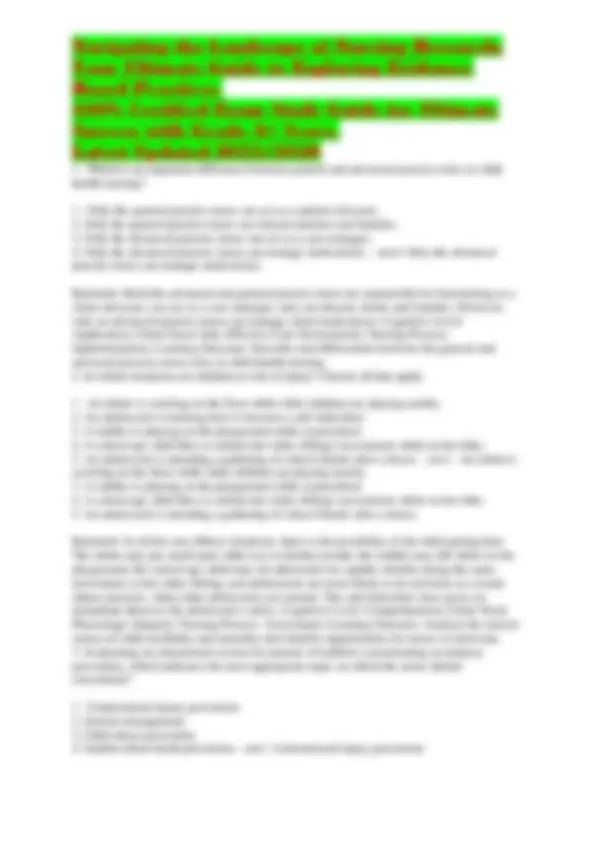
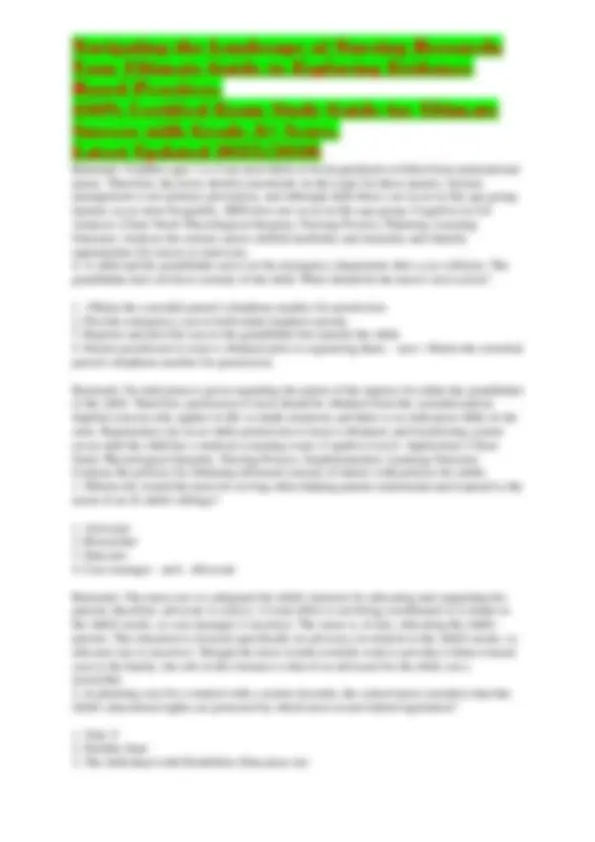
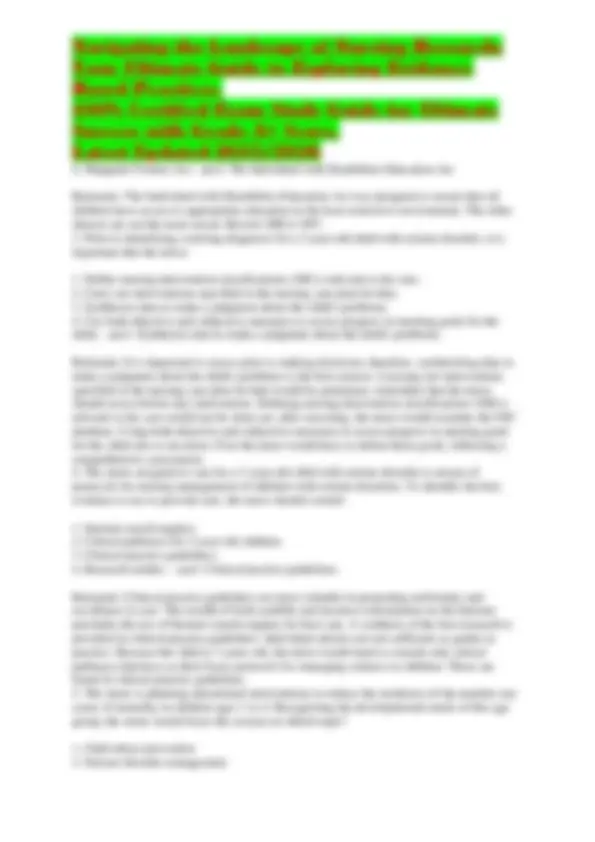
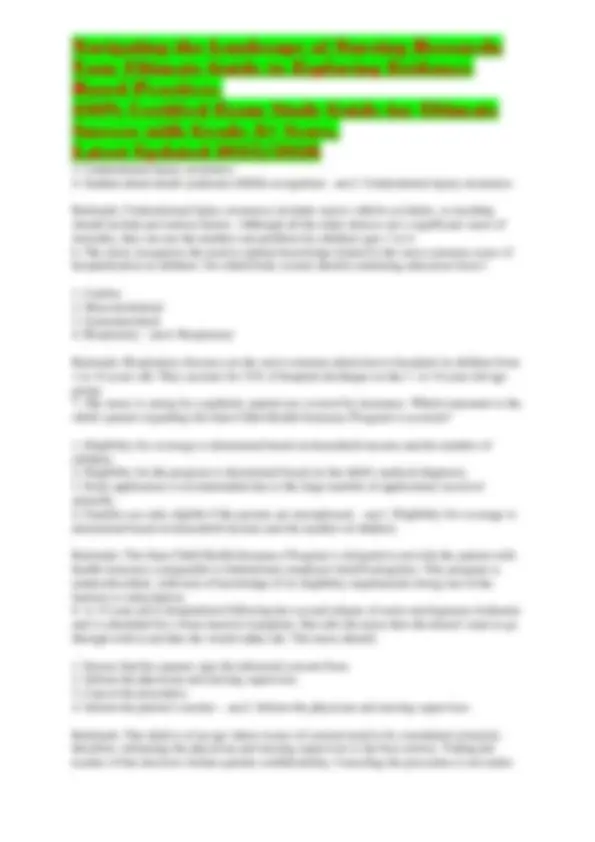
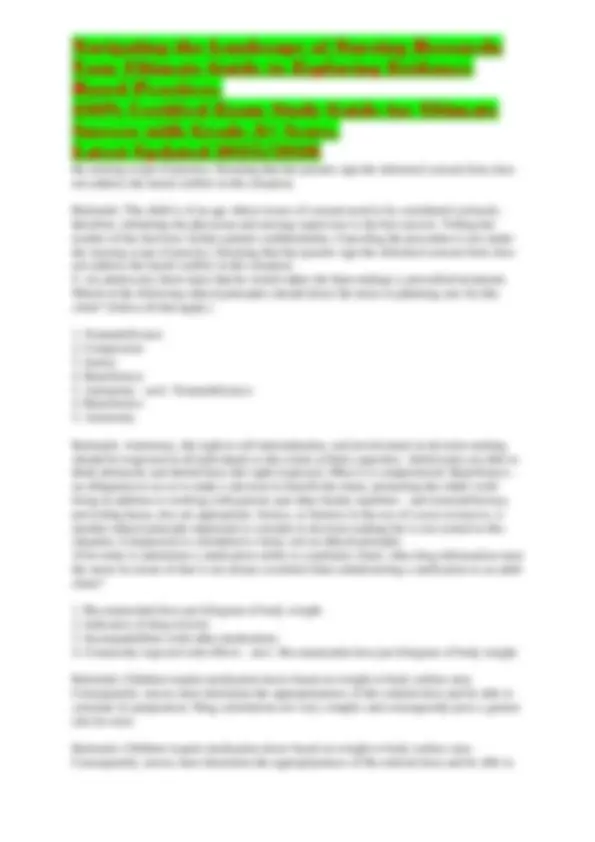
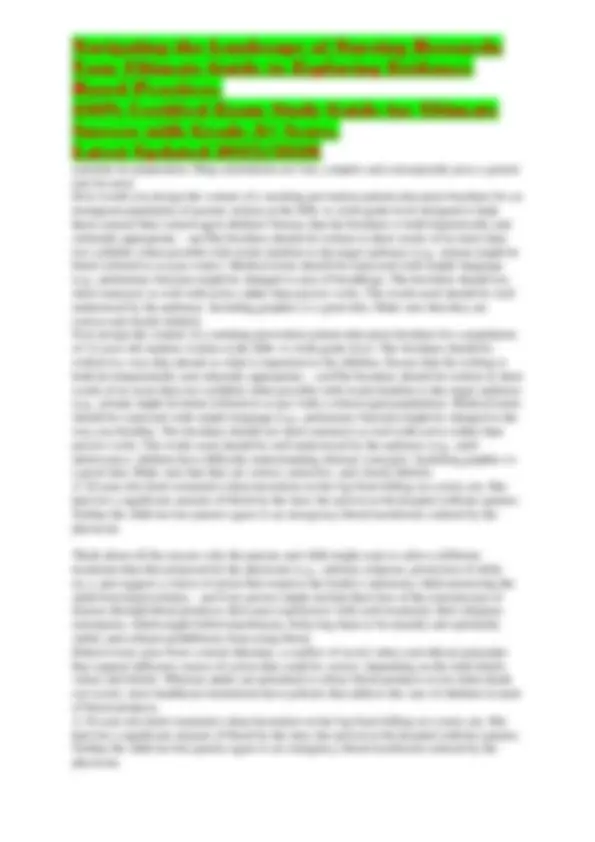
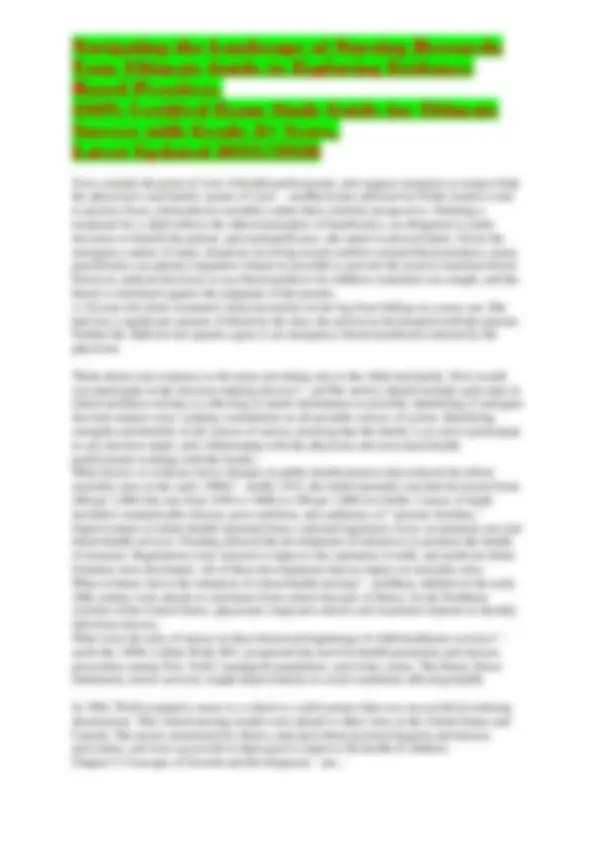

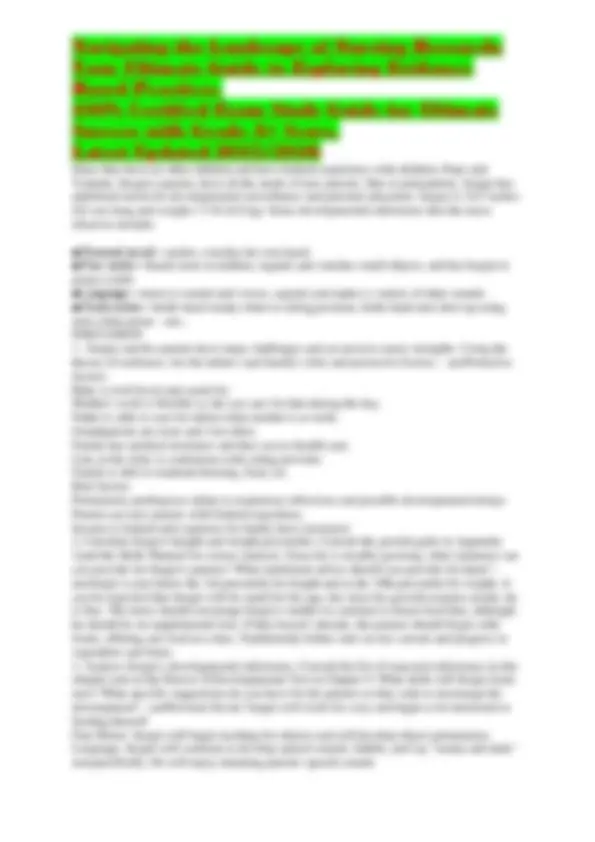
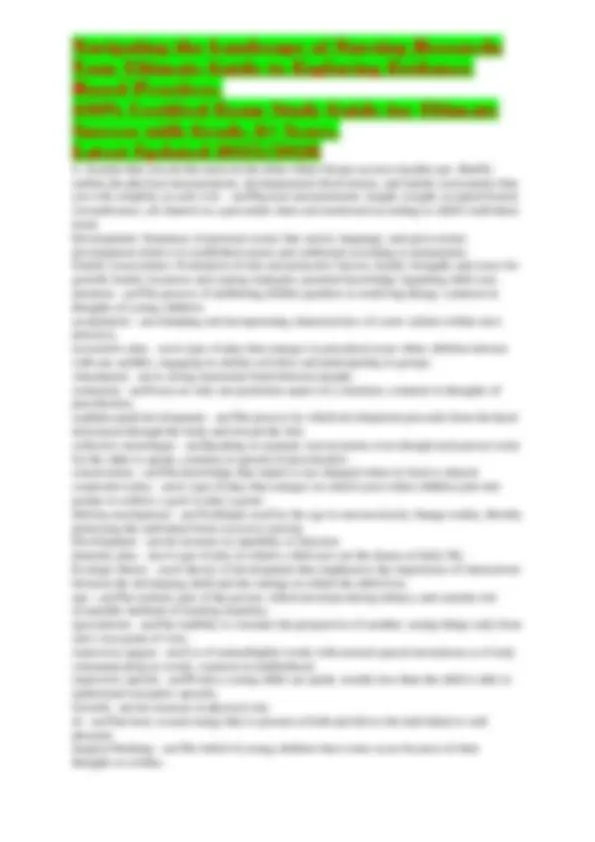
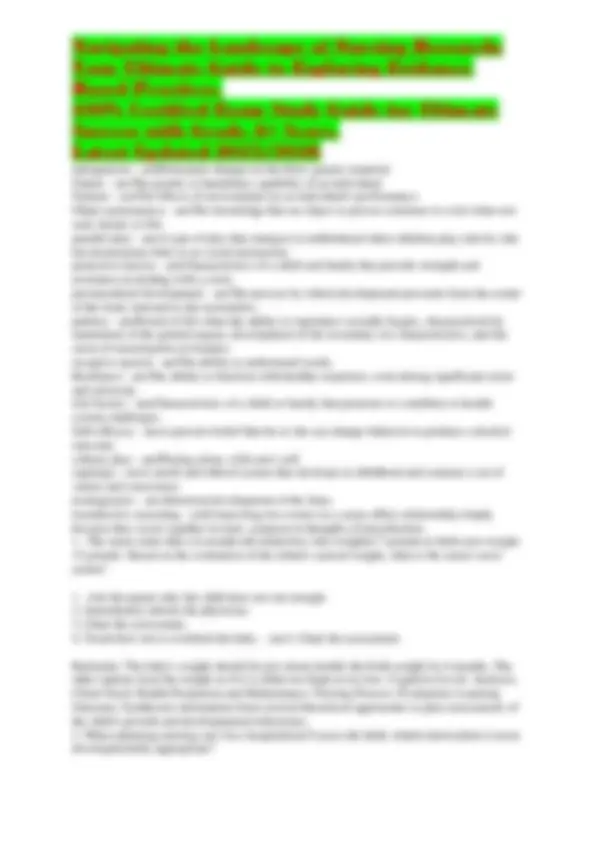
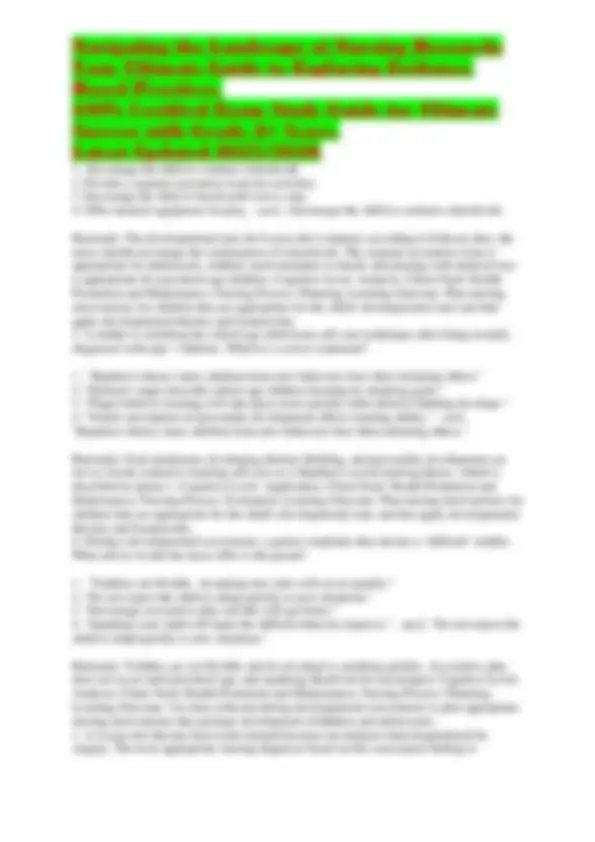
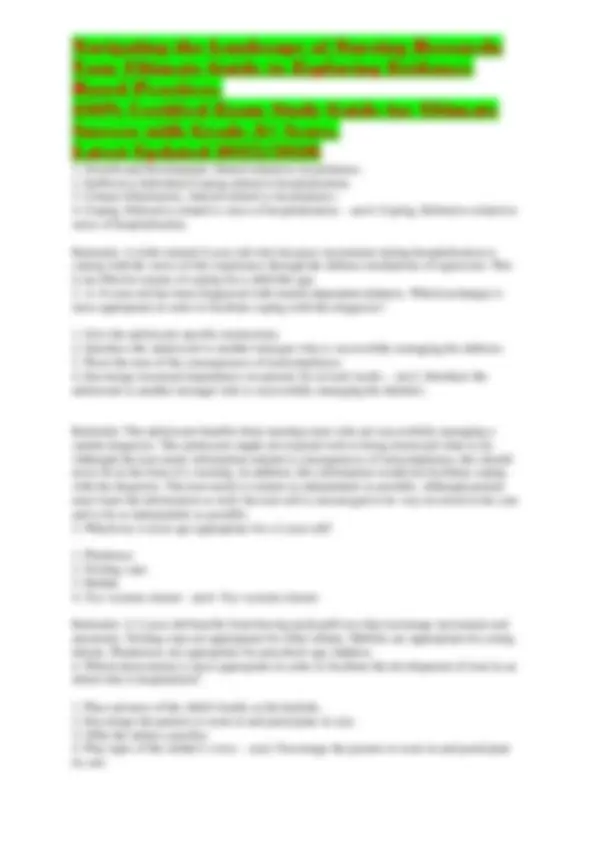
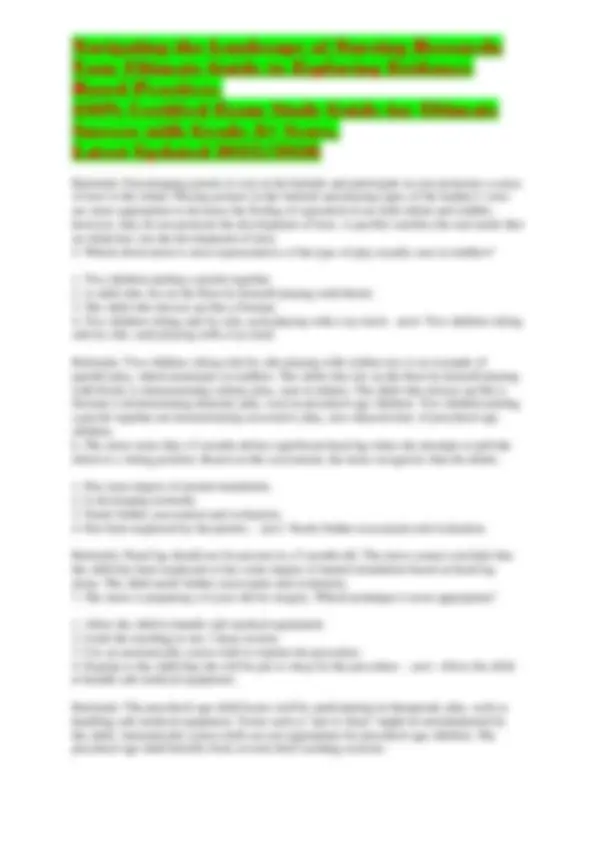
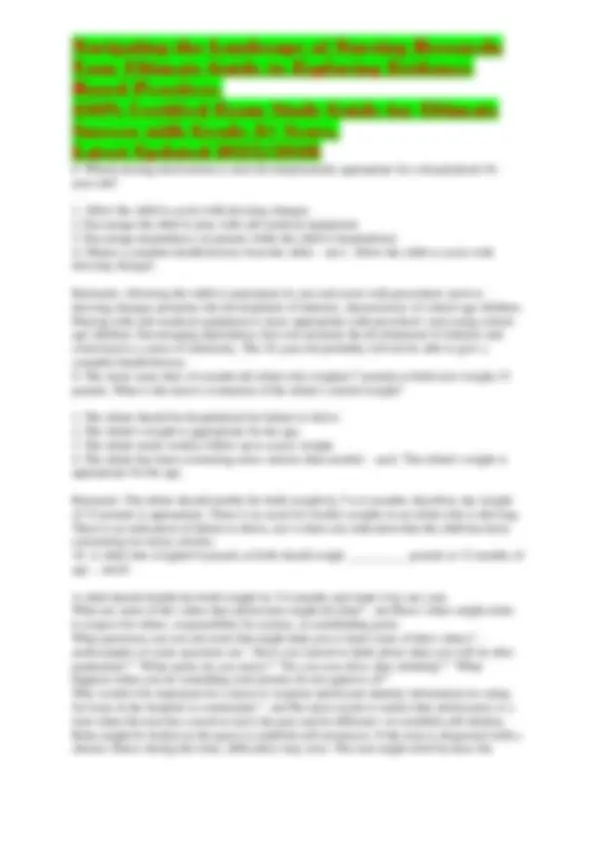
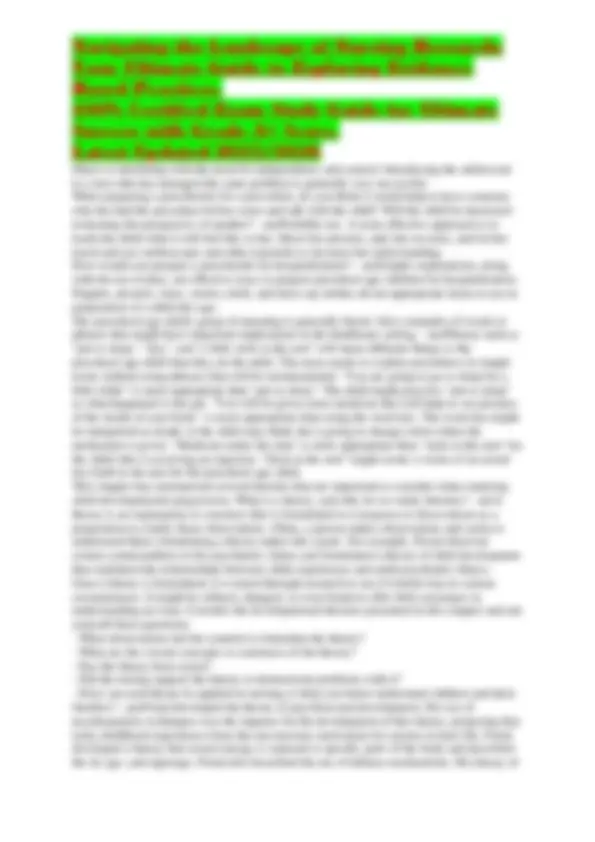
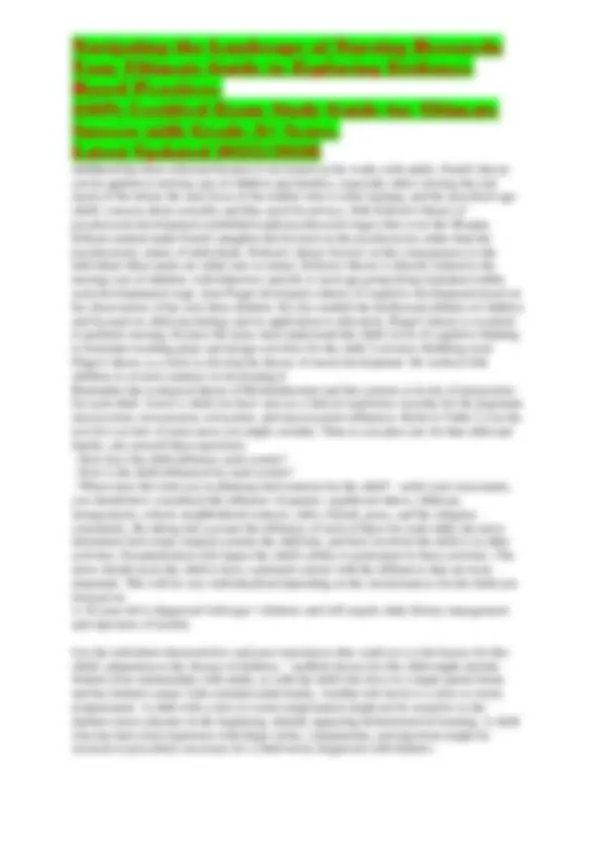
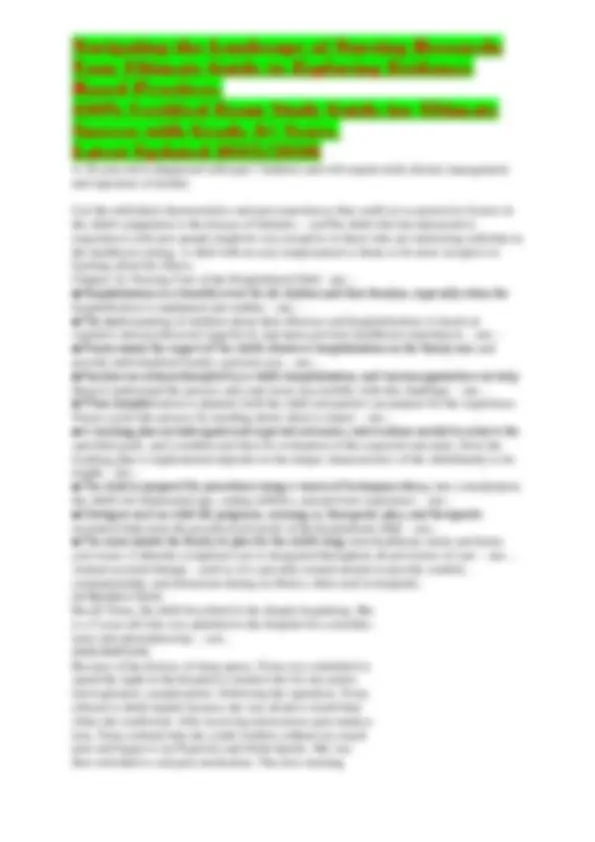
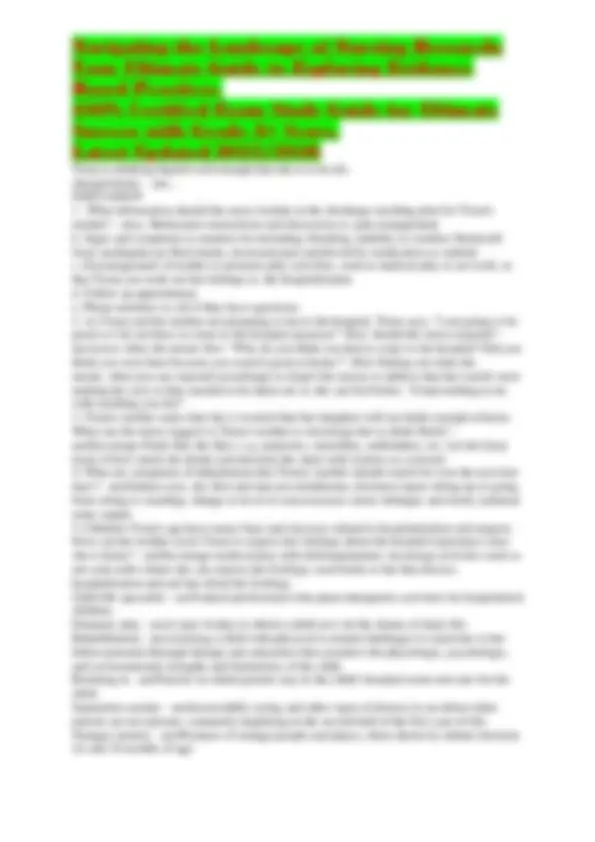


Study with the several resources on Docsity

Earn points by helping other students or get them with a premium plan


Prepare for your exams
Study with the several resources on Docsity

Earn points to download
Earn points by helping other students or get them with a premium plan
Community
Ask the community for help and clear up your study doubts
Discover the best universities in your country according to Docsity users
Free resources
Download our free guides on studying techniques, anxiety management strategies, and thesis advice from Docsity tutors
Navigating the Landscape of Nursing Research: Your Ultimate Guide to Exploring Evidence Based Practices. 100% Certified Exam Study Guide for Ultimate Success with Grade A+ Score. Latest Updated 2025/2026
Typology: Exams
1 / 184

This page cannot be seen from the preview
Don't miss anything!





























































































Sampling in research may be defined as: a. insurance that each person has a chance of being included in the study. b. establishment of criteria for eligibility to participate in a study. c. identification of the population in which the researcher is interested. d. selection of a subset of a population to represent the whole population. - ansANS: D Sampling involves selecting a group of people, events, behaviors, or other elements with which to conduct a study. Samples are expected to represent a population of people. A researcher is interested in studying lifestyle management in patients with inflammatory bowel disease. The researcher contacts the Crohn's and Colitis Foundation of America to determine how to best access this patient population. Patients with inflammatory bowel disease are an example of which of the following? a. Accessible population b. Element c. Sample d. Target population - ansANS: D The target population is the entire set of individuals who meet the sampling criteria. Subjects who participate in a study of patients with inflammatory bowel disease are described as the: a. accessible population. b. element. c. sample. d. target population. - ansANS: C A sample is that group of people who are representing the entire population and participating in the study. Samples are expected to represent an entire population. The Crohn's and Colitis Foundation of America referred the interested researcher to a local chapter of the organization. The local chapter agreed to send out letters on behalf of the researcher inviting potential subjects to contact the researcher if they are willing to participate in a study. Potential subjects in this situation would be described as the: a. accessible population. b. element. c. sample. d. target population. - ansANS: A An accessible population is the portion of the target population to which the researcher has reasonable access. The population from which the researcher selects the actual study sample is referred to as the: a. accessible population. b. scientific population. c. target population. d. theoretical population. - ansANS: A
An accessible population is the portion of the target population to which the researcher has reasonable access. The sample is obtained from the accessible population. In a study of liver transplant recipients, the researcher specifies that the subjects must be 18 years of age or older and the recipient of only one liver transplant. These criteria are an example of: a. demographic attributes. b. exclusion criteria. c. extraneous variables. d. inclusion criteria. - ansANS: D Inclusion criteria are those characteristics that the subject or element must possess to be part of the target population. The adequacy of a sample would be primarily based on which of the following criteria? a. Method chosen for sample selection b. Representativeness of the population c. Size of the total population d. Willingness of subjects to participate - ansANS: B A sample needs to be representative in terms of characteristics, such as age, gender, ethnicity, income, and education A sample that accurately reflects the characteristics of the population from which it is drawn is a: a. cluster sample. b. purposive sample. c. random sample. d. representative sample. - ansANS: D Representativeness means that the sample, accessible population, and target population are alike in as many ways as possible. Sample attrition would be reflected by the: a. average death rate of the population under study. b. inability to access identified members of a population. c. number of patients who die while participating in a study. d. number of patients who drop out of a study. - ansANS: D Sample attrition or mortality is the withdrawal or loss of subjects from a study The term "comparison group" in research refers to the group of patients in a: a. nonrandom sample who do not receive a treatment. b. nonrandom sample who receive a treatment. c. random sample who do not receive a treatment. d. random sample who receive a treatment. - ansANS: A If nonrandom methods are used for sample selection, the group not receiving a treatment is referred to as a comparison group.
b. Ensures obtaining a larger sample at lower cost c. Internal validity is strengthened with this type of sampling d. Involves the selection of certain subjects from a convenience sample - ansANS: A With stratification, the researcher can use a smaller sample size and achieve the same degree of representativeness in relation to the stratified variable as a large sample acquired through simple random sampling. Cluster sampling is: a. a form of nonprobability sampling used in small surveys. b. also known as multistage sampling. c. unlikely to result in sampling errors. d. useful when the target population is found in a small geographical area. - ansANS: B Both terms, cluster sampling and multistage sampling, have the same meaning in sampling methods. A person is shopping in the mall and is approached by individuals who identify themselves as researchers for a local food chain. They ask the person to participate in their study by answering a few questions. As a subject for this survey, the person was selected by which method of sampling? a. Convenience sampling b. Purposive sampling c. Random sampling d. Systematic sampling - ansANS: A Findings of an intervention study with a convenience sample: a. are generalizable to a wider group of patients with related problems. b. are to be discounted because they are extremely biased. c. provide no useful information. d. should be replicated before being applied to a wider population. - ansANS: D Representativeness of the sample is a concern in convenience sampling, and generalizability is therefore limited. Which type of sampling will get the largest number of subjects in the shortest period of time? a. Cluster sampling b. Convenience sampling c. Network or snowball sampling d. Random sampling - ansANS: B Which of the following types of sampling is considered to be the weakest? a. Cluster b. Convenience c. Quota d. Systematic - ansANS: B Which of the following samples is least likely to be representative of the overall population?
a. Convenience b. Quota c. Random d. Stratified random - ansANS: A An advantage of convenience sampling is: a. ease in obtaining subjects. b. increased internal validity and control. c. low risk of sampling bias. d. representativeness of sample is ensured. - ansANS: A Convenience samples are inexpensive, accessible, and usually require less time to acquire than other types of samples. Which of the following study types would require the largest sample size? a. Correlational b. Experimental c. Grounded theory d. Phenomenology - ansANS: A Descriptive studies and correlational studies often require very large samples. In these studies multiple variables may be examined, and extraneous variables are likely to affect subjects' responses to the variables under study. The sample size needed for a study increases when: a. the alpha level is increased from .01 to .05. b. the number of variables in the study increases. c. a one-tailed versus a two-tailed statistical test is used. d. the sensitivity of the instruments used is high. - ansANS: B As the number of variables under study increases, the sample size needed may increase. A researcher wants to obtain a sample of individuals who are HIV positive. Which of the following sampling methods would be the most effective way to obtain a sample? a. Accidental sampling b. Cluster sampling c. Network sampling d. Simple random sampling - ansANS: C Which of the following is true about network sampling? a. Eligibility criteria do not need to be defined carefully. b. Finding large numbers of subjects by this means is easy and economical. c. Sample representativeness is guaranteed by using this technique. d. Subjects who have knowledge of a situation, often sensitive or not socially acceptable, are identified by others in the same type of situation. - ansANS: D
a. Selected four states b. Southeast c. Southeast who are actively working d. United States - ansANS: B This study used a cluster sampling technique that is one type of random sampling plan. In a study investigating nurses' attitudes toward taking care of respiratory disease patients who had a long history of smoking, the researcher randomly selected a sample from a list of all the registered nurses from a randomly selected list of four states in the Southeast. If the researcher also selected the sample by randomly selecting nurses who smoke and those who do not, what sampling technique is being used? a. Cluster b. Quota c. Stratified random d. Systematic - ansANS: C Stratified random sampling is used when certain characteristics of the group are identified and then proportionately included in the randomly chosen sample. Assuming the researcher first knew whether or not a nurse smoked, then this represents that sampling technique. Which of the following sets of terms represents an appropriate pairing of a probability sampling method and a corresponding nonprobability sampling one? a. Cluster sampling—snowball technique b. Simple random sampling—convenience sampling c. Stratified random sampling—quota sampling d. Theoretical sampling—quota sampling - ansANS: C Stratified random sampling and quota sampling both attempt to balance the sample in terms of known characteristics in the population. Which of the following is true about sample size? a. An adequate sample size is particularly important to detect differences when they do in fact exist. b. Evaluating the possibility of a Type I error will help determine sample size. c. Finding a significant difference in study groups occurs most often with smaller samples. d. Sample size is especially important to support significant findings. - ansANS: A Evaluating the adequacy of the sample size is very important when no differences have been found. Too small a sample can result in no difference being detected, even when there actually is one. A researcher reports on a study conducted to determine if a new educational program has helped dialysis patients become more compliant with their fluid restrictions. The findings indicated that there was no difference. The report did include that a power analysis was performed to determine if the sample size (n = 100) was adequate. The power level was .5. What should the reader conclude?
a. A sample of 100 is certainly adequate in a clinical study. The researcher should adjust the educational program. b. Chances are high that a Type I error has occurred. c. Findings of no difference are not surprising; it is difficult to make an impact on this population of patients. d. There is a high likelihood that the sample size was not adequate, and the study should be replicated using more subjects. - ansANS: D A power level needs to reach .8 to be acceptable, and this one had only .5. There is a good chance that a Type II error occurred, and the study should be replicated. Apart from sample size, which of the following is typically not considered when determining the power of a study? a. Sensitivity of the instruments used b. Number of variables c. Skill of the researcher d. Data analysis techniques - ansANS: C The skill of the researcher does not affect the statistical power of a study. All other answers are correct. To detect a significant difference between two groups when the effect size is small, what should the researcher do? a. Conduct a pilot study. b. Obtain a different sample. c. Increase the sample size. d. Perform additional analysis. - ansANS: C Increasing the sample size makes it easier to detect a difference. Which of the following types of studies would need the largest sample size? a. Case studies b. Descriptive studies c. Experimental studies d. Quasi-experimental studies - ansANS: B Descriptive studies often require very large samples. Multiple variables may be examined, and extraneous variables are likely to affect subject response(s) to the variables under study. Why do qualitative researchers need to be as concerned with sample size as quantitative researchers do? Qualitative researchers: a. are reaching the objectives of their study in a similar way. b. need subjects who are able and willing to share their knowledge, oftentimes in repeated and more in-depth interviews than subjects in quantitative studies. c. need to gain a narrow focus rather than a broad perspective as their research purpose. d. will be analyzing the data with statistical techniques that require certain numbers of subjects. - ansANS: B
In qualitative research, the researcher looks for data saturation, which is reached when no new information is being discovered from additional subjects. Which of the following factors do not influence saturation of data and therefore sample size in a qualitative study? a. Quality of the data b. Randomization of the sample c. Scope of the study d. Study design - ansANS: B Randomization of the data is a concern for quantitative research designs. All other choices are concerns for saturation of data in qualitative research. Which of the following research settings is not correctly paired with the type of setting? a. Clinical research unit—highly controlled setting b. Indoor playroom—natural setting c. Primary care clinic—partially controlled setting d. Subject's home—partially controlled setting - ansANS: D A subject's home would be a natural research setting, so it is paired incorrectly with "partially controlled setting." validate and refine existing knowledge and generate new knowledge that directly and indirectly influences nursing practice. - ansThe primary purpose of nursing research is to:
"Cancer patients who receive music therapy complain less frequently of pain and require less pain medication than cancer patients not receiving music therapy."
"In this study, pain is reflected as a score between 0 and 10 on the Post-operative Pain Rating Scale."